15th century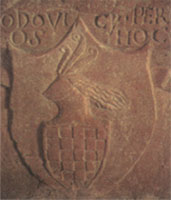
Croatian Coat of Arms in The
Senj Cathedral,
1491,
which belonged to the family of Perovich in
Lika, mentioned in the accompaning Latin text
(at that time the
Turkish Empire is near immediate vicinity of the towns of Senj, Karlovac and Sisak)
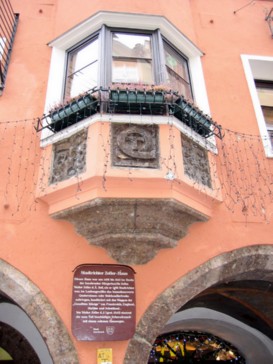
Croatian coats of arms can be seen on the ceiling of the Stadtrichter Zeller Haus (Herzog Friedrichstr. 35)
of the city magistrate (Stadtrichter) in Innsbruck, Austria, dating from 1495/96.
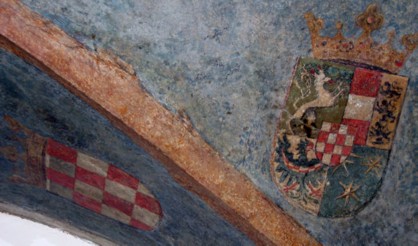
Many thanks to Ivan and Aleksandar Szabo for kind help.
16th century
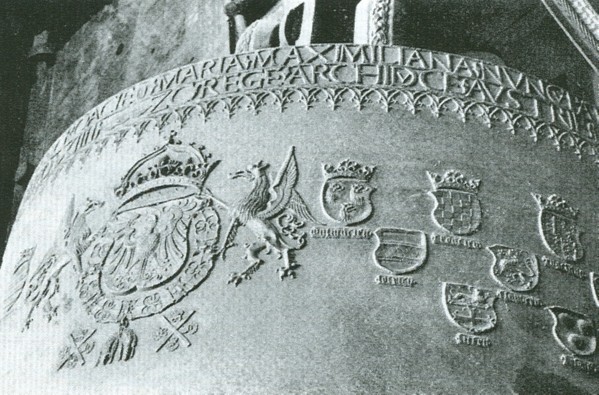
From the bell in Schwaz near Innsbruck, 1503,
diameter 189 cm, weight 4.2 tons, 60 coats of arms in three lines
Dalmatian and Croatian coats of arms occupy the first two places in the first line (!)
(Ivan Bosilj: Zvona, Graphis, Zagreb, 2000, p. 53; with permission of prof.dr. Zvonko Bencic)
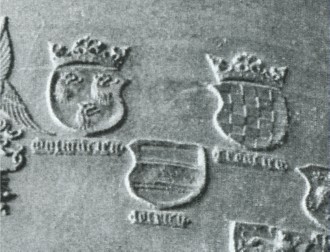
Dalmatie and Croacie on the top, from a bell in Schwaz near Innsbruck, Austria, 1503.
In the church of Sainte-Waudru in Monsu, Belgium, there is a Croatian Coat of Arms dating from 1511, see [Claus]

The artist Hans Burgkmair (1473-1531) included Croatian and Dalmatian coats of arms
in his painting of King (Ludovik I) Louis (1516-1526) and in his genealogy of the Habsburgs.
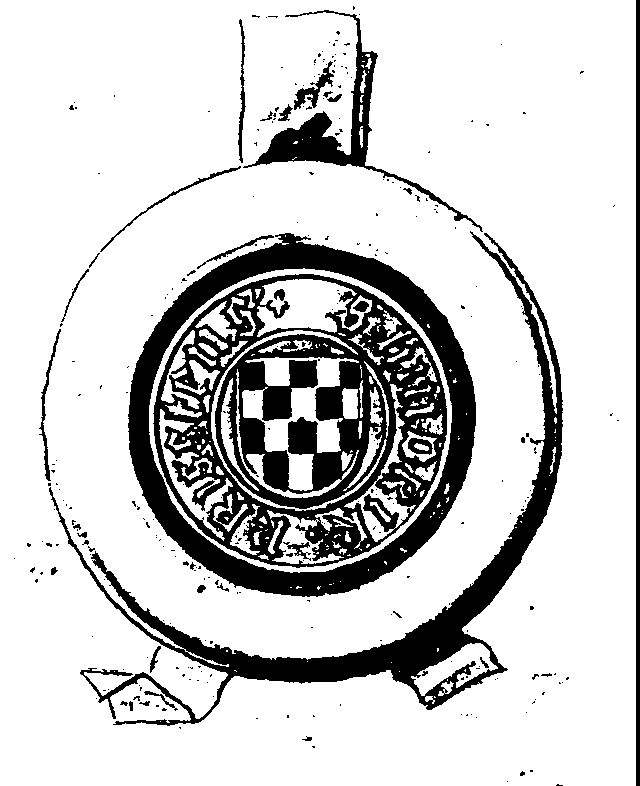
The coat of arms owned by the Swedish noble family Kristiernsson from Oestergoetland in Sweden. During the fifteenth century, this family served the Scandinavian king Erik VII of Pomerania and his governor in Oestergoetland, count Ivan VI. Anž Frankopan (in Sweden known as Johan Franke or Johan Vale). The central part of Kristiernsson's seal corresponds to the traditional chequered Croatian coat of arms, known since the eleventh century. During the king Erik of Pomerania's travel through Croatia on his way to the Holy Land, his followers and king's shield-bearer Hindrik Kristiernsson made a longer break in Frankopan's city of Senj. The coat of arms very similar to that of Kristiernsson's, belonged to the noble family Perović from Senj. For more details see dr. Mladen Ibler (Denmark): THE CROATIAN COAT OF ARMS - FROM FRANKOPAN'S SENJ TO SWEDEN?
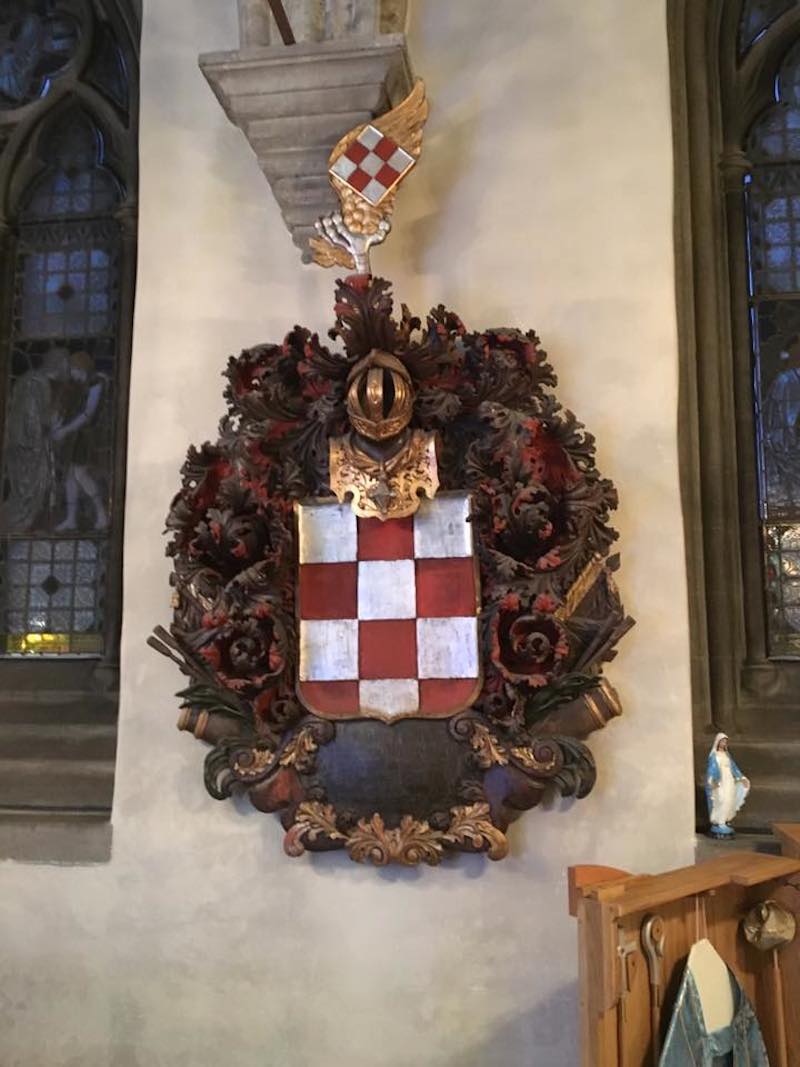
In January 2016, Mr. Peter Turkalj living in Sweden, in the city of Oerebro, sent us another evidence
of Croatian Coats of Arms in Sweden, dating probably from the 16th century.
Many thanks to Mr. Peter Turkalj.
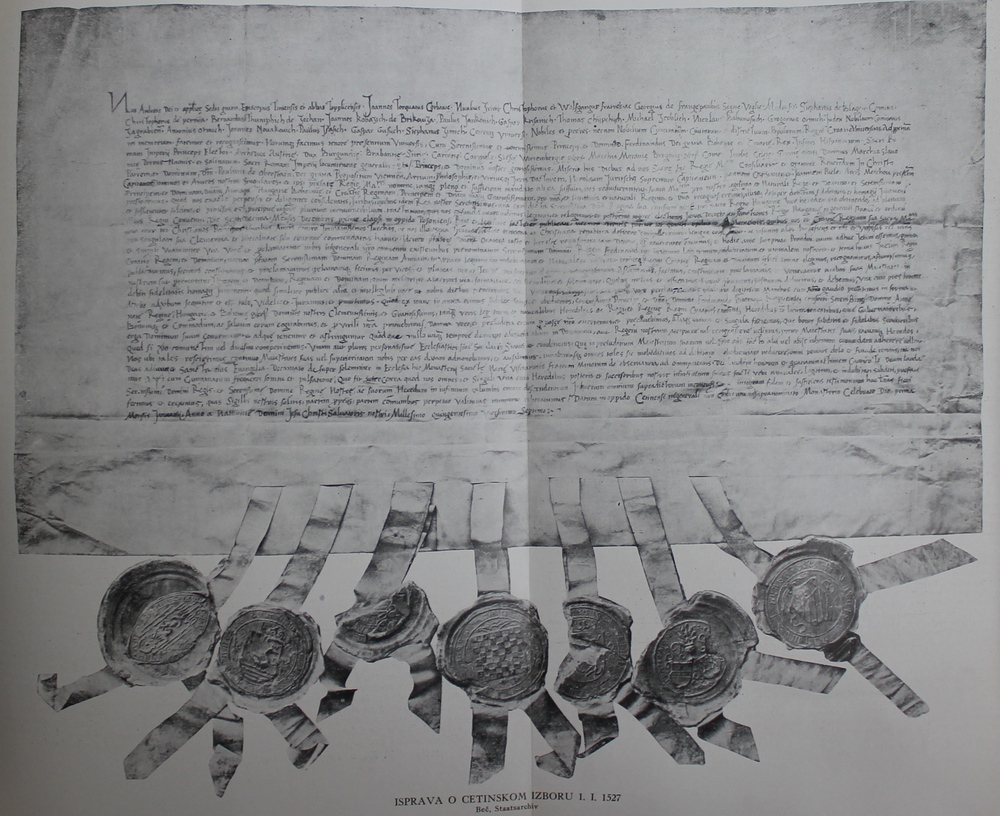
January 1st, 1527, Croatian legal document kept in the State Archive in Vienna (Staatsarchiv), with the first known official appearance of Croatian Coat of Arms.
Source Croatian Encyclopaedia (see under Cetingrad)
Text in original Latin and in Croatian translation.
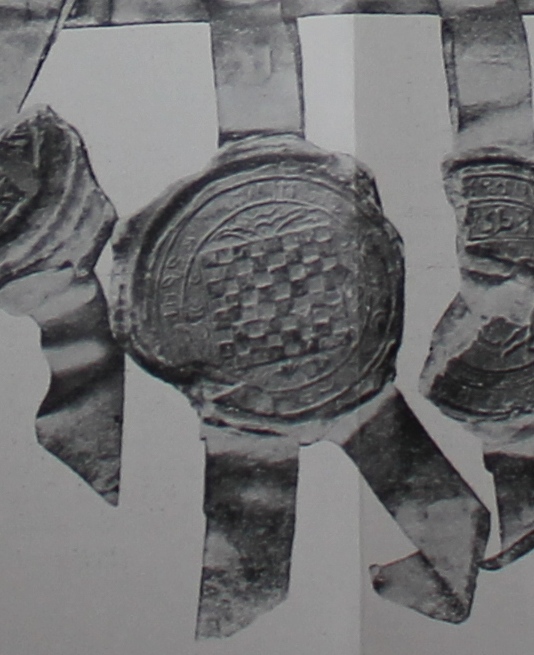
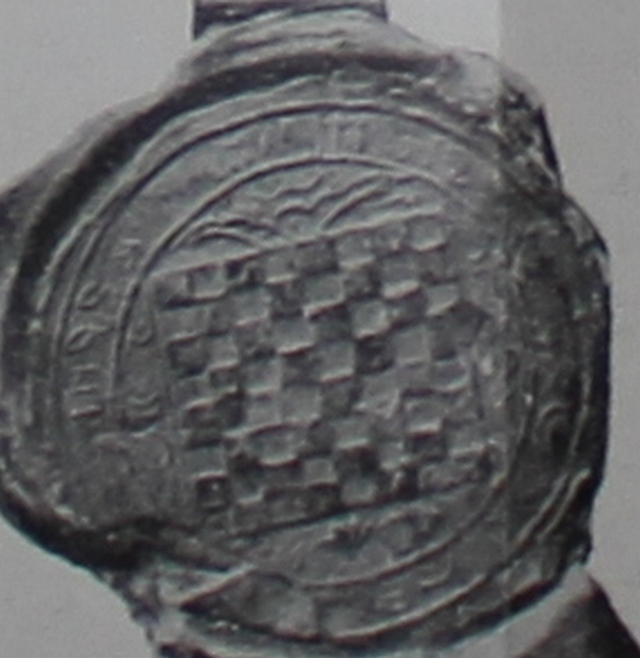
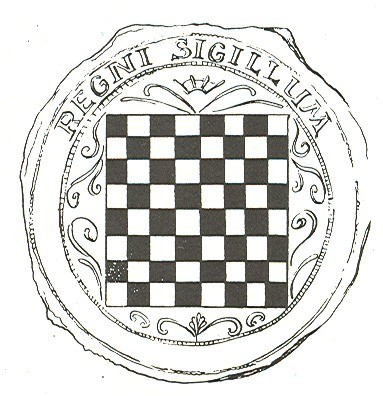
Sigillum regni with Croatian coat of arms, Cetingrad 1527
In Vienna there are old Croatian coats of arms on several places,
on the Grabe square (around 1760) , and in Schoenbrun
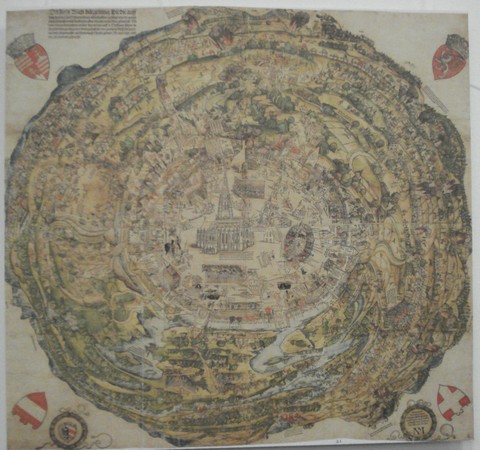
Vienna in 1529, during the first Turkish siege of the city. Stephanusdome, the famous Vienna Cathedral, is in the center.
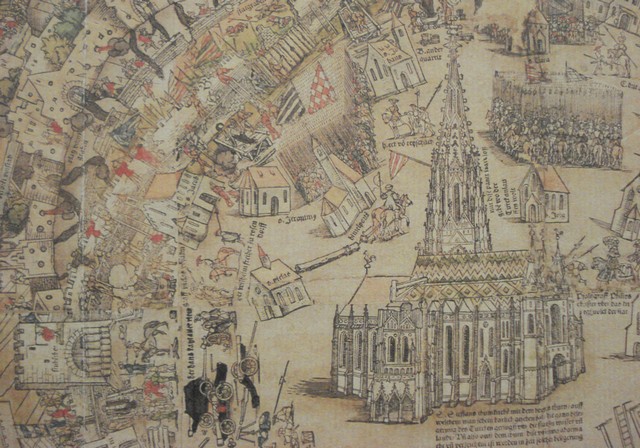
A detail from the above map: Croatian Coat of Arms is in the middle top, to the left of the Cathedral.
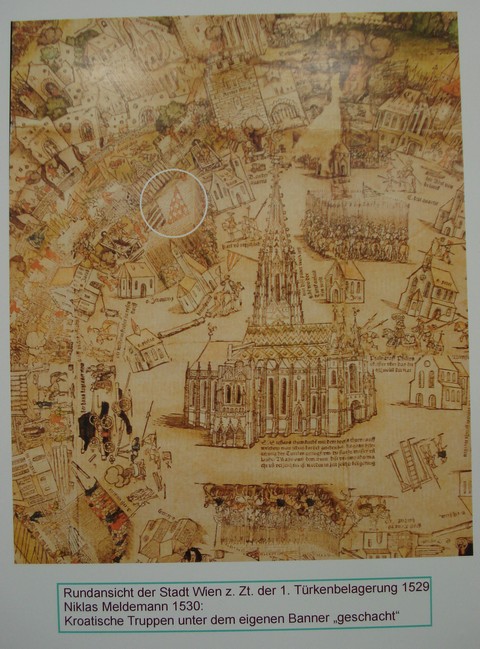
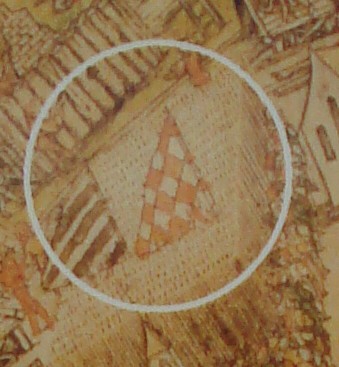
Croatian defensive forces under their Croatian flag in Vienna in 1529, during the first Turkish siege of the city.
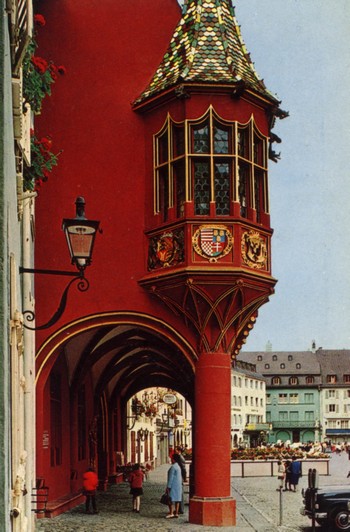
A picture postcard from Freiburg im Breisgau, Wuerttemberg, Germany
(Muensterplatz 24, 79098 Freiburg)
The decorations of the building are from 1530-32.
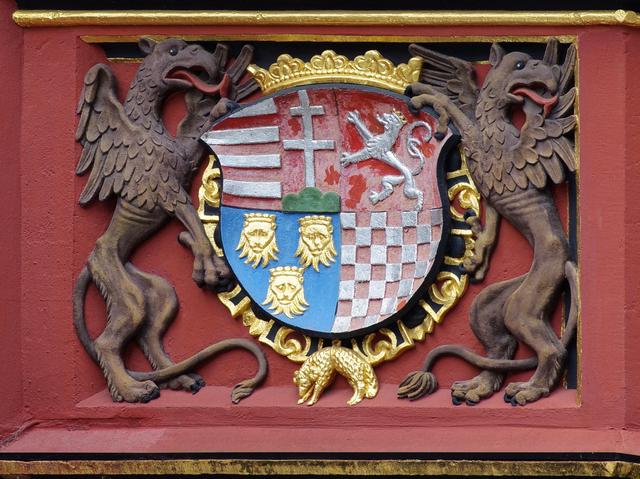
Many thanks to Dr. Siniša Miličić for his kind information.
Faust Vrančić, distinguished Croatian lexicographer, was at the court of the Roman-German Emperor and Croatian-Hungarian King Rudolph II, who was crowned by Antun Vrančić, Faust's uncle. Now doubt, these are some of the reasons why in the chruch of st. Vitus in Hradčani Cathedral in the Prague, we can see fantastic Croatian Coats of Arms. Karl of the Stier (Karlo Štajerski), brother-in-law of King Rudolph II, was in charge of the Croatian Military Frontier, where in 1578 he made the foundations of the new very strong fortress of Karlovac, which was important in the struggle of Croatia against the Turkish Ottoman Empire onslaughts. Among numerous great artists and scientists at the Royal Court in Hradčani, Faust Vrančić, the Royal Secretary, was in close contact with Tyho de Brahe and Johannes Kepler.
Lit.: Vladimir Muljević: Hrvatski znanstvenici Faust i Antun Vrančić, Encyclopaedia Moderna, 2(42) (1993), pp.122-136.
The presence of very beautiful Croatian Coats of Arms in the Cathedral of St Vitus in Hradčani, Prague, Czechia, is related to the fact that Rudloph II was the then King of Croatia (among other countries).
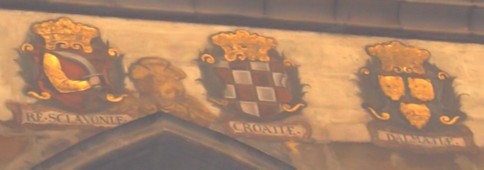
16th century Croatian coats of arms in the Cathedral of St Vitus in Hradcany, Prague, Czechia:
Regnum Sclavoniae, Croatiae, Dalmatiae, on the left from the main altar.
They appear together with several dozens of other old European coats of arms.
These drawings seem to be unknown in Croatian heraldic literature.
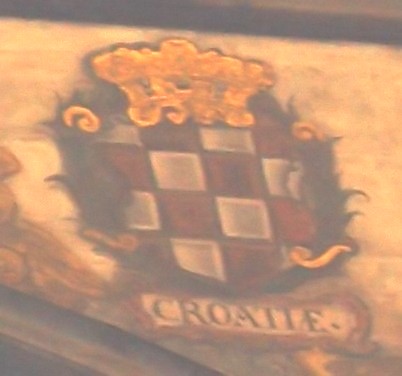
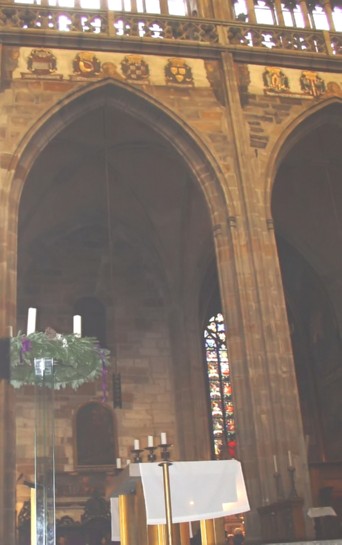
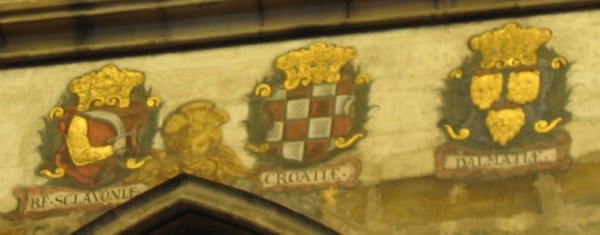
Re. Sclavoniae, Croatiae, Dalmatiae (Kingdom of Slavonia, Croatia, and Dalmatia)
Note that here the coat of arms of Sclavonia is the same as that of Bosnia.
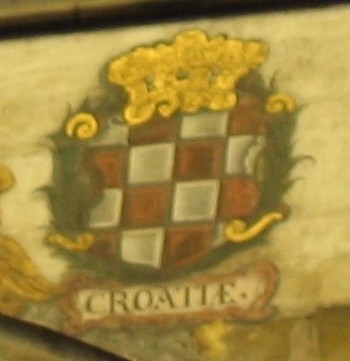
For very interesting traces of Croatian Glagolitic Script in Prague see here (in Croatian)
17th century
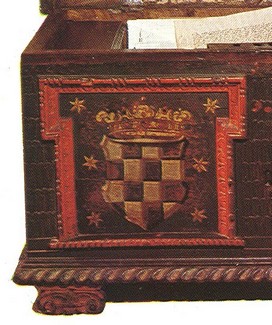
Chest of privileges of the Kingdom of Dalmatia, Croatia and Slavonia, with Croatian legal documents, 1643
kept in the Croatian State Archives
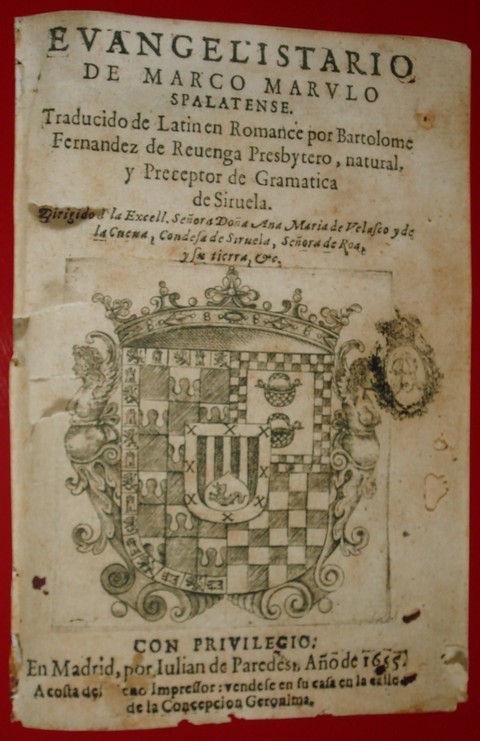
Marko Marulic's Evangelistarium published in Spanish in Madrid in 1655. Note Croatian Coat of Arms in the middle. Photo exhibited by The Split Literary Circle.
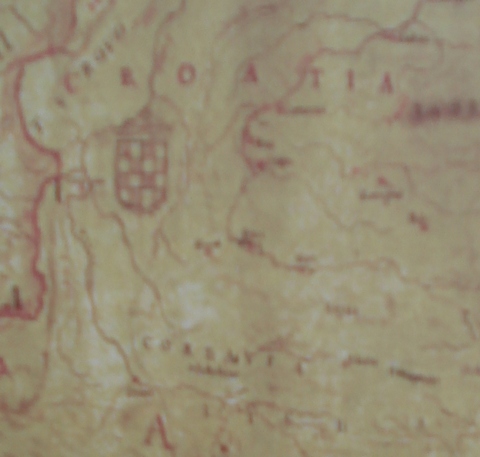
A part of the map of Illyrian provinces (roughly Croatia + Bosnia and Herzegovina) which had the privilege to use St. Jerome institutions in Rome, 1660.
(kept in Rome, in Papinski hrvatski zavod sv. Jeronima - Papal Croatian collegium of St. Jerome). See [Krasic, Počelo je u Rimu, p. 456].
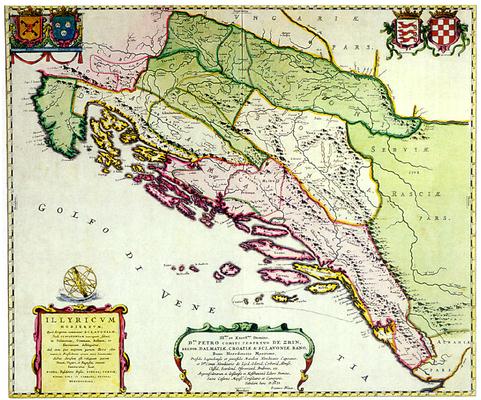
photo from Croatian Historical Musem
The map is dedicated to Petar Zrinski, ban of Croatia. It was created at the workshop of Joannes Blaeu in Amsterdam as an addition to the work by Ivan Lucic, "De Regno Dalmatiae et Croatiae libri sex", Amsterdam, 1666. Blaeu had inserted the map in Atlas Maior in 1667, and dedicated it to the Croatian ban Petar Zrinski (bottom of the map, in the middle):
To the most illustrious and noble lord, Prince Peter of Zrin, the ban of the Kingdom of Dalmatia, Croatia and Slavonia, hereditary ban of the Littoral, hereditary captain of the Legrad fortress and Medimurje peninsula, master and hereditary prince of Lika, Odorje, Krbava, Omis, Klis, Skradin, Ostrovica, Bribir etc.., Master of Kostajnica and the sliver mine at Gvozdansko, councillor and chamberlain to his anointed imperial majesty, master Ioannes Blaeu dedicates this map.
The above text is from Croatian Historical Musem.
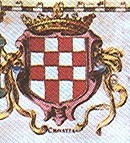
From the map of Illyricum in the book by Ivan Lucius Lucic:
De Regno Dalmatiae et Croatiae libri sex,
Amsterdam and Frankfurt, 1666
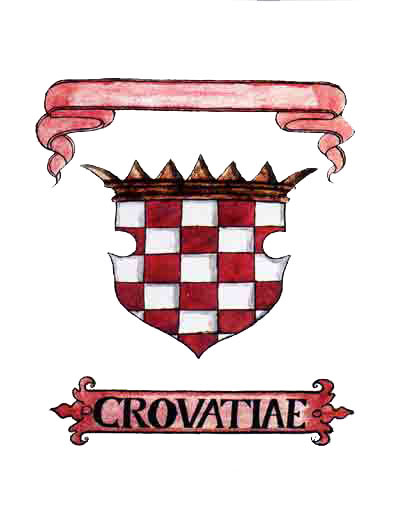
Fojnica Heraldry from 1675 (kept in Franciscan Monastery in Fojnica, Bosnia and Herzegovina)
the only collection of old coats of arms known in Bosnia and Herzegovina
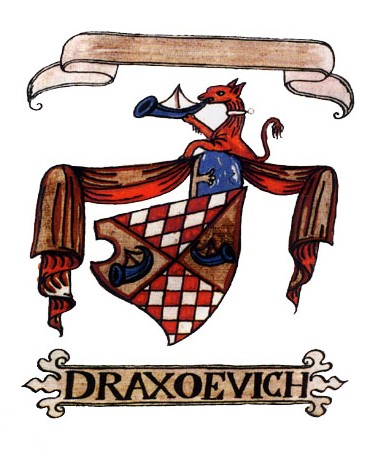
Coat of Arms of Prince Zarko Drazojevic (1438-1508), from the Poljica Principality
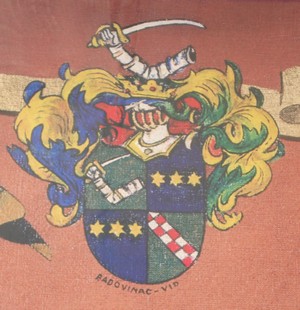
Coat of Arms of Badovinac Vid, Zumberak, exhibited in the Museum of Zumberak in Stojdraga
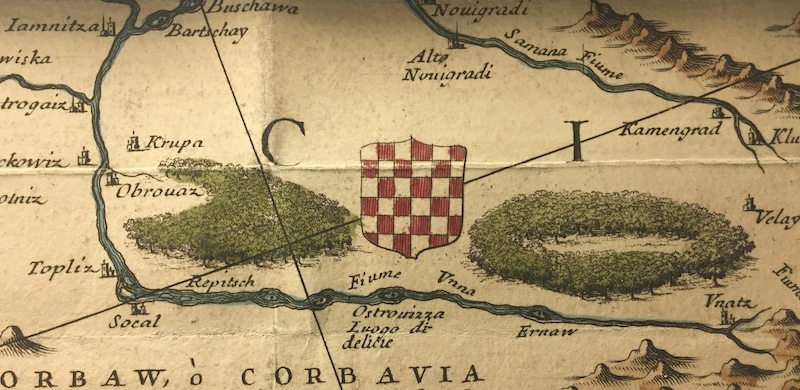
Vicenzo Maria Coronelli: The map of Istria and northern Dalmatia, arround 1688 (a detail)
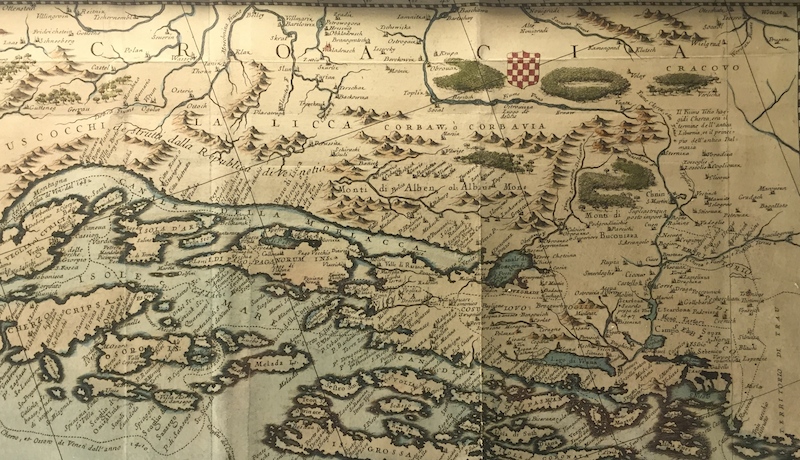
Vicenzo Maria Coronelli: The map of Istria and northern Dalmatia, arround 1688 (a part of the map)

Coats of arms of Croatia, Dalmatia and Slavonia of
Nikola III ErdĂśdy, ban (governor)
of the United Kingdom (Trojedna Kraljevina) of Croatia, Dalmatia and Slavonia 1680-1693.
The coats of arms are on his official ban's flag, and this is the oldest known such ban's flag.
The flag is kept in the
Zagreb Cathedral. Photos by
Sanjin Strukić.
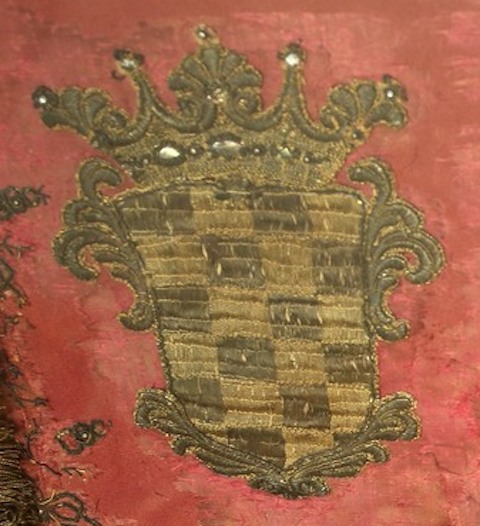
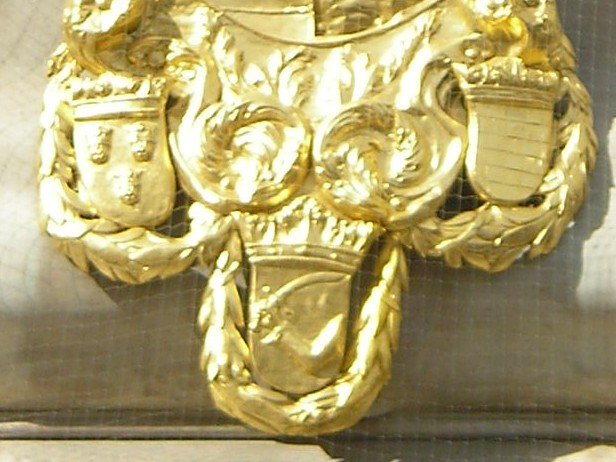
Vienna (in Am Graben, not far from St. Stephen's Cathedral), Austria; Pestsaule (1693): Coat of Arms of Dalmatia, Croatia and Bosnia (Rama).
By the courtesy of Mr. Kristian Dumancic, Vienna.
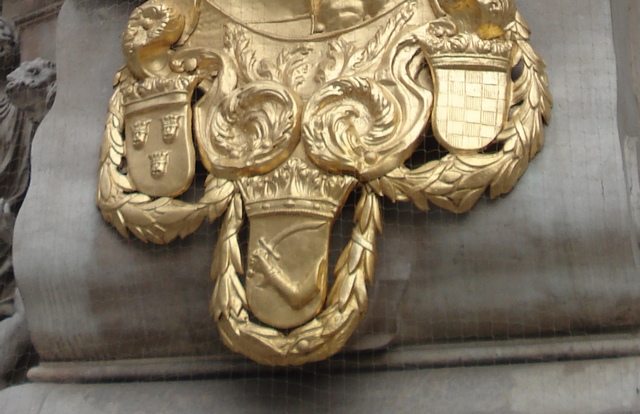
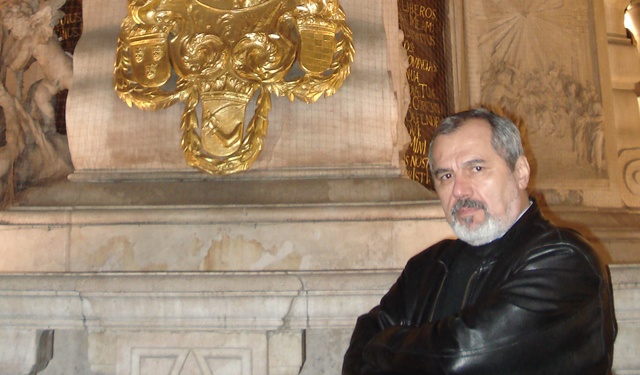
Mr. Mijo Jurić by Croatian Coats of Arms in Am Graben in Vienna, Austria
18th century
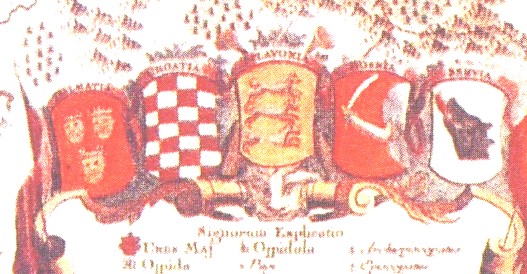
A detail from Seutter's map, Augsburg 1709
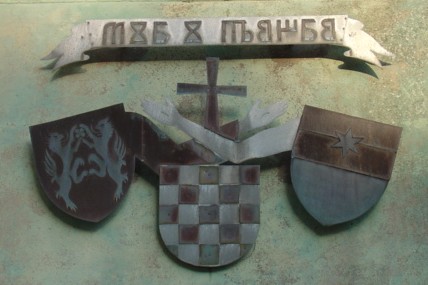
The inscription "Peace and Good" (Mir i dobro) in the Croatian Glagolitic Script,
at the main entrance of the Franciscan convent on the islet of Kosljun near the town of Punat
on the island of Krk
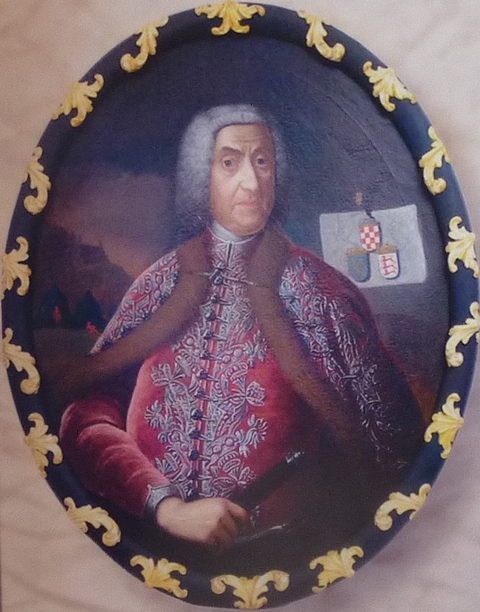
Ivan V Drašković, ~1660-1733
Ban (governor) of the United Kingdom of Croatia, Slavonia and Dalmatia
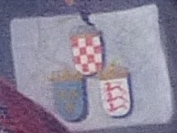
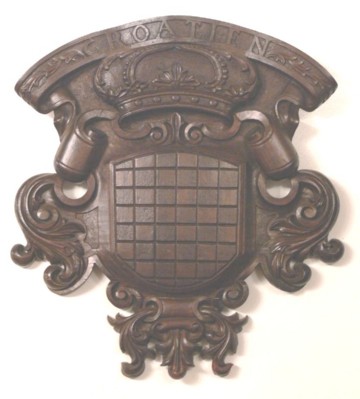
Croatian Coat of Arms (Croatien) in Sevnica, Slovenia, 17th century;
there are also nice wooden Coats of Arms of Slavonia (Schlavon.) Dalmatia (Dalmaci.),
and of the city of Zagreb (Agram)
The Coats of Arms were first placed in the lower palace in Sevnica,
and then moved to the upper palace, to its Conference hall
(many thanks to Blandina and Ante Markovic for information and photos)
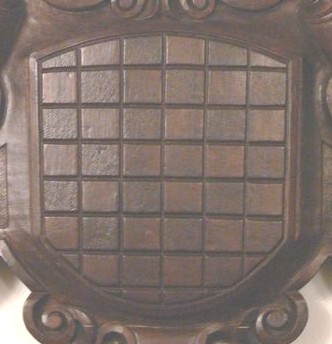
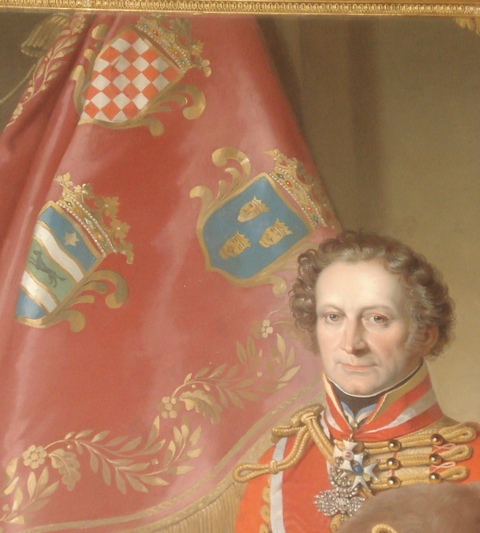
Ivan PĂĄlffy, Croatian ban (Governor) 1704-1732, ban of United Kingdom of Croatia, Slavonia and Dalmatia.
Portrait kept in the Croatian History Museum, Zagreb (detail).
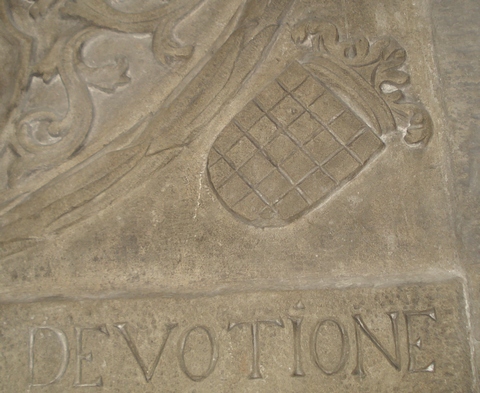
Croatian Coat of Arms from 1732 in the church of St Kapistran in Ilok, Croatian town on the Danube river
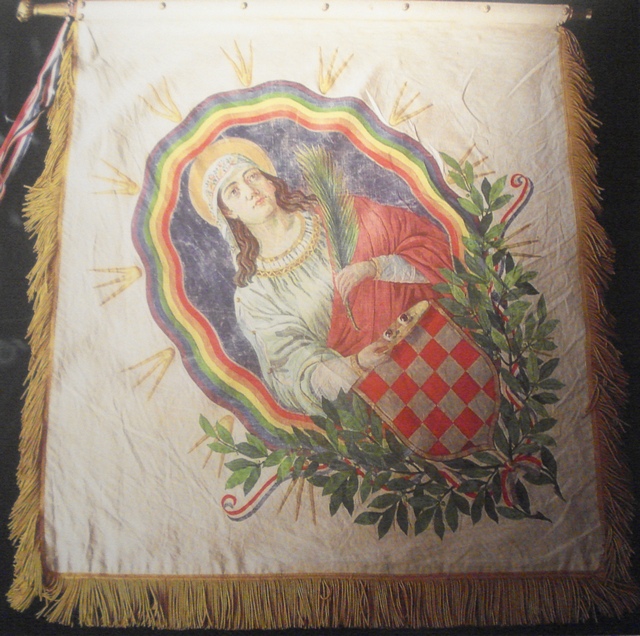
Coat of arms of the Plemenita turopoljska općina -ĂĂĂĂĂĂĂĂĂĂĂĂÂ Noble district of Turopolje from 1737
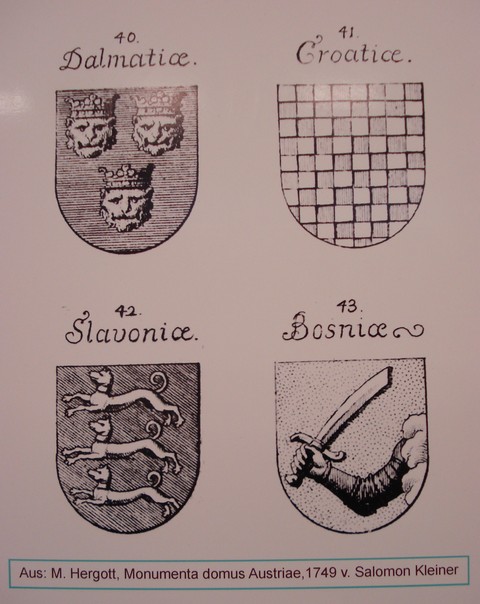
Croatian Coats of Arm from 1749.
By the courtesy of Josip Sersic and Mijo Juric, Vienna 2009.
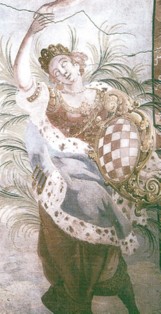
The Baroque church of St. Martin Bishop, Donja Voca (north of Zagreb), mural by Ivan Ranger, 18th century
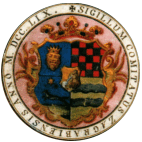
Official seal of the Zagreb zupanija (county),
with Croatian coat of arms, 1759,
Croatian coat of arms and the seal were granted by Queen Maria Theresia
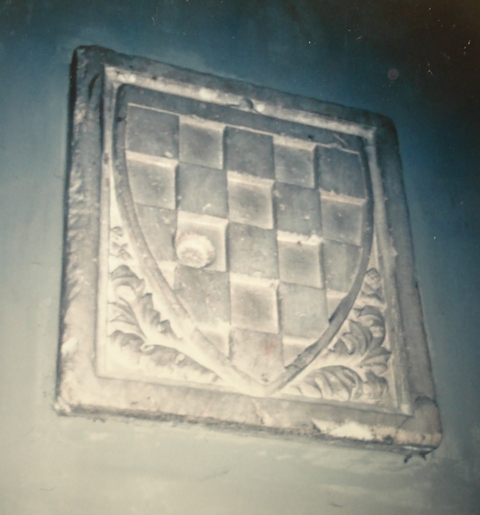
Croatian Coat of Arms in the Cathedral of St. Lovrijenac, Lugano, Switzerland (date unknown), on a right pillar.
The Croatian Coat of Arms is engraved also on bishop's chain in Lugano (we do not possess its photo).
Information and photo by the courtesy of Mr. Seno Markulin, Sidney, Australia.
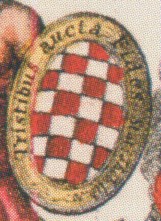
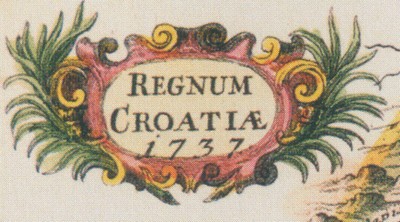
Two details from Regnum Croatiae, map of Croatian Kingdom by Johann van der Bruggen, Venice 1737
source [Novak et al, p. 54]
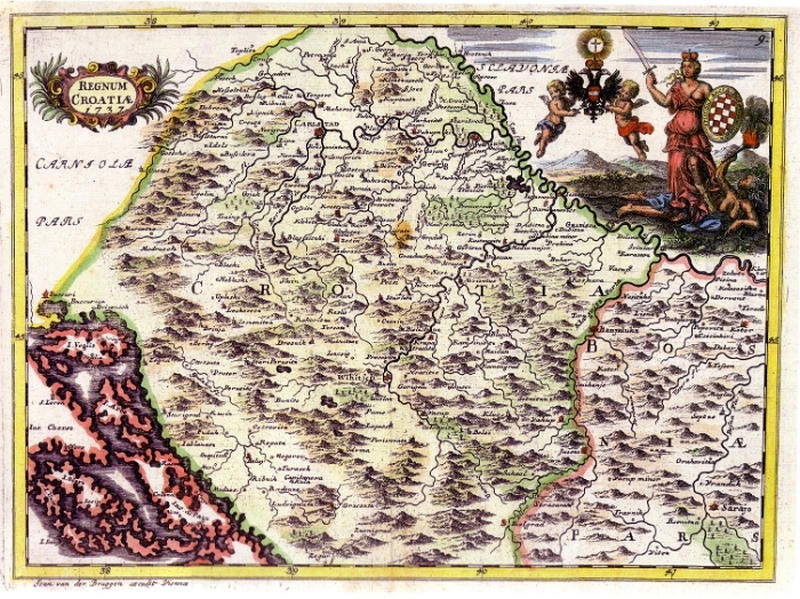
Regnum Croatiae, map of Croatian Kingdom (Johann van der Bruggen, Venice 1737).
Source Old Adriatic Sea - Croatia maps
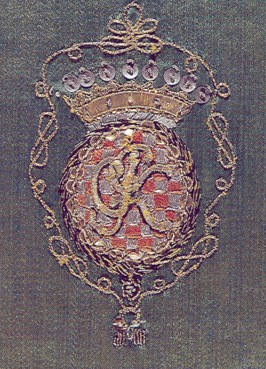
Countess Katarina Patacic (1750-1811), from the title page of her book Pesme Horvatzke (Croatian Poems), Varazdin 1781
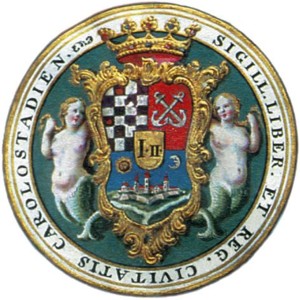
Grb of the town of Karlovac, 1781
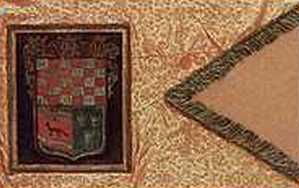
Konjička zastava (equestrian flag), United Kingdom of Croatia, Slavonia and Dalmatia, 1797, source
19th century
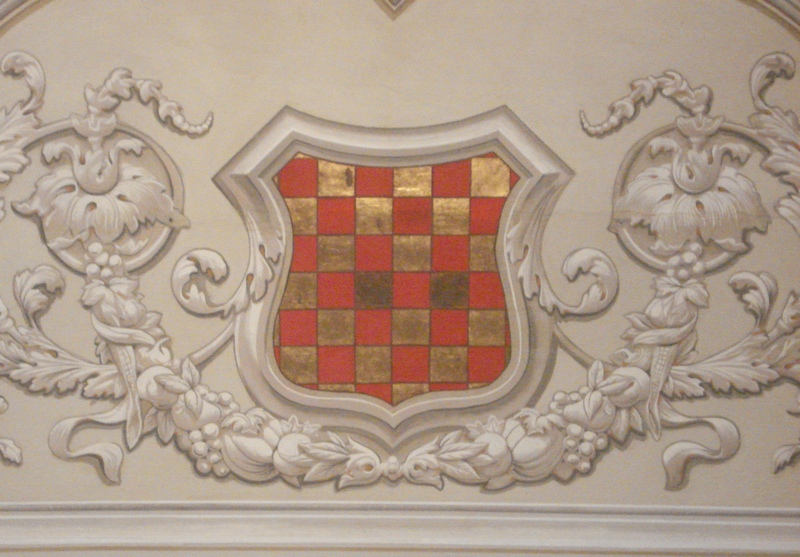
Croatian Coat of Arms in the city of Sombor, the City Hall, 1808, and
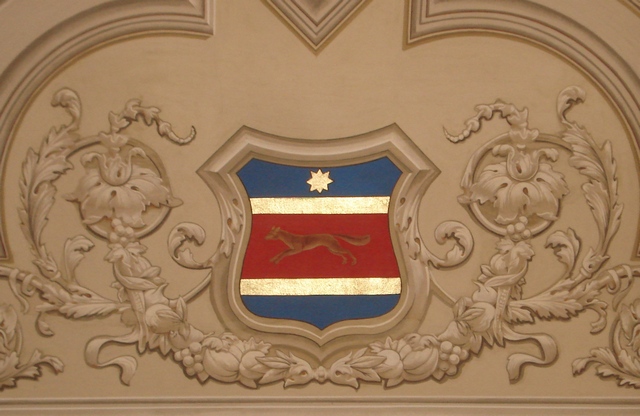
the Coat of Arms of Slavonia, and
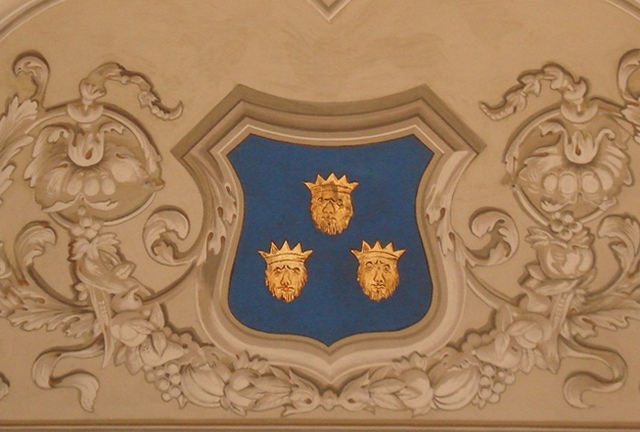
the Coat of Arms of Dalmatia.
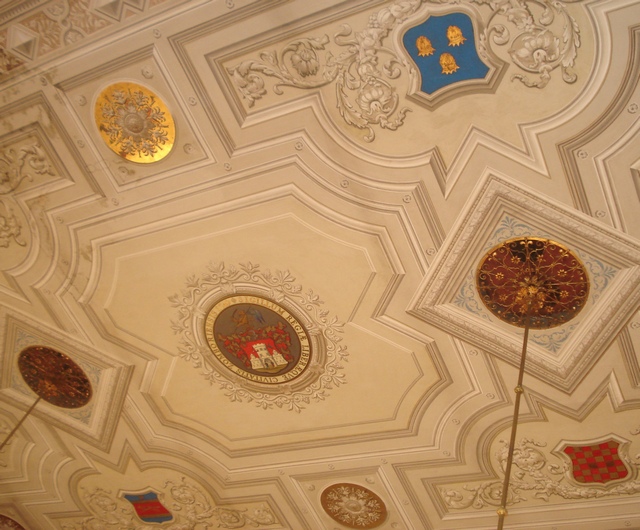
The ceiling of the City Hall of Sombor with the Coat of Arms of the the city of Sombor in the middle,
surrounded with Coats of arms of the United Kingodm of Croatia, Slavonia and Dalmatia
(bottom right, left, and up on the right respectively; missing on the photo, up on the left, Erdely's Coat of Arms)
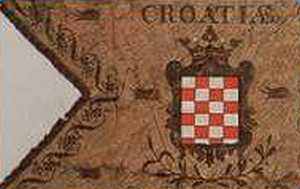
Krunidbena zastava (coronation flag), 1830, source
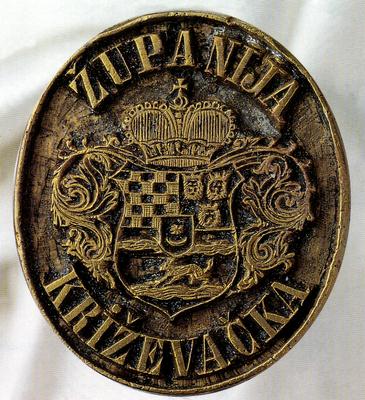
Seal of the Križevci County, 19th century
photo from Croatian History Museum
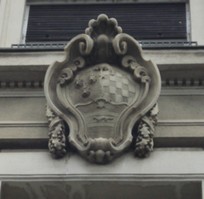
Croatian Coat of Arms above the main entrance to the building of Savska 2, Zagreb, built in 1832
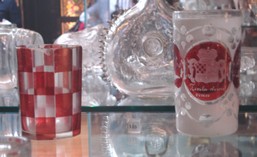
Two glasses with Croatian Coats of Arms made in Osredek, the left one from 1840-1845, and the right one from the middle of the 19th century,
both kept in the Museum of Arts and Crafts (Muzej za umjetnost i obrt), Zagreb
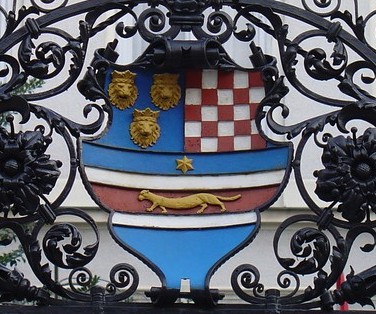
Croatian coat of arms in front of Croatian History Institute, Zagreb
(Coat of Arms of United Kingdom of Dalmatia, Croatia and Slavonia)
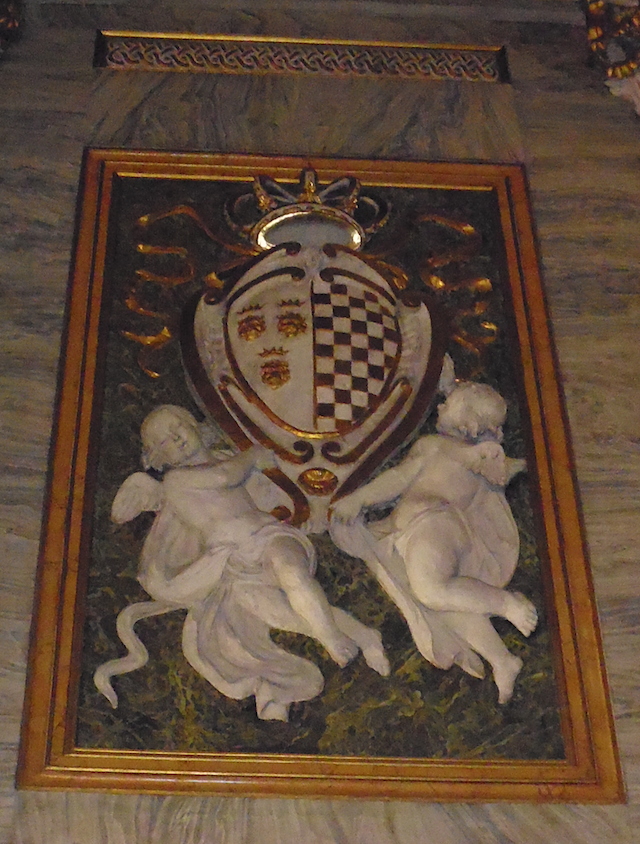
Croatian church of St. Jerome in Rome, with Croatian Coat of Arms on the wall.
Photo by the courtesy of Mirna Lipovac, Zagreb.
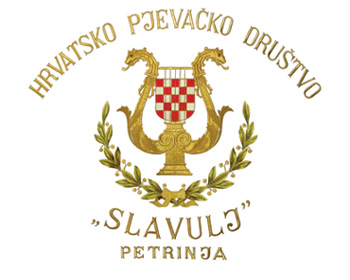
Croatian Singing Society "Slavulj" (Nightingale), 1864

Pervaci i članovi sjedinjene hrvatske opozicije (Dignitaries and members of united Croatian oposition), 1864
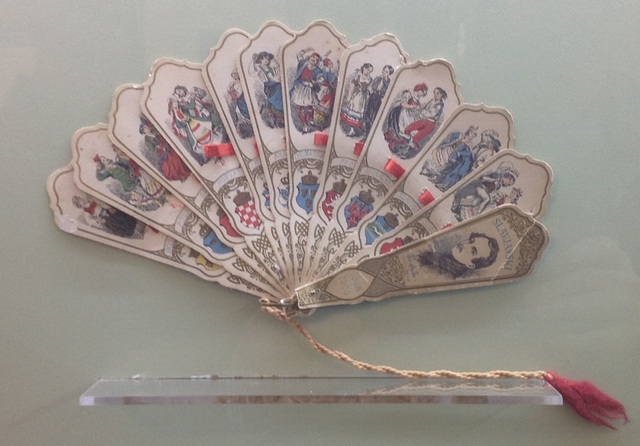
Croatian Coats of Arms from the 19th century in the City Museum of the town of Samobor near Zagreb.
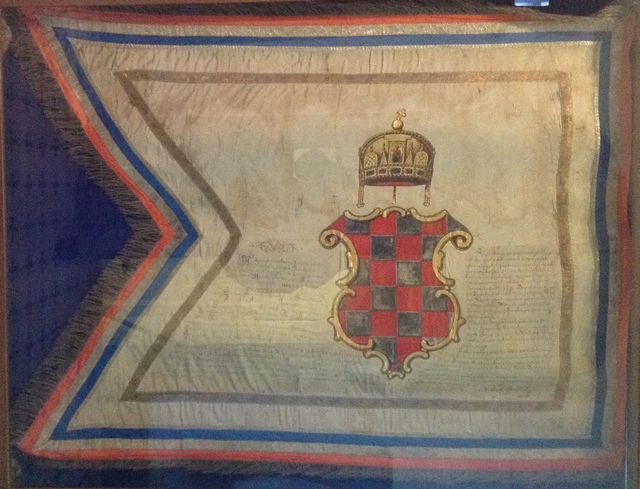
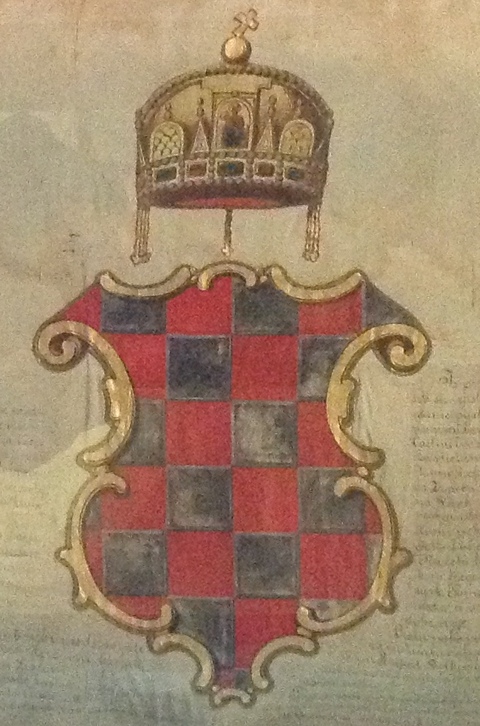
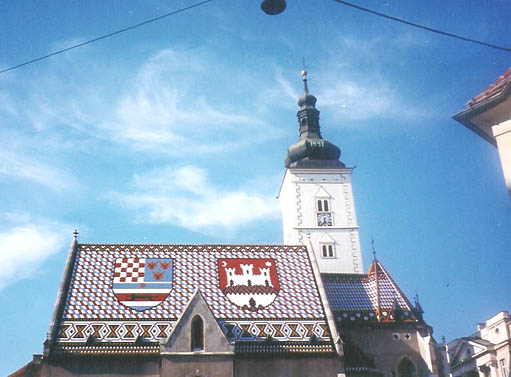
Croatian coat of arms on the roof of the Church of St. Marko in Zagreb, since 1878
(photo by Hippo)
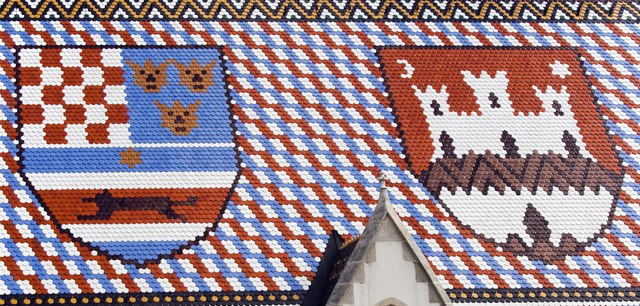
A detail from the roof of the church of St Mark in Zagreb, which is quite near the City Council.
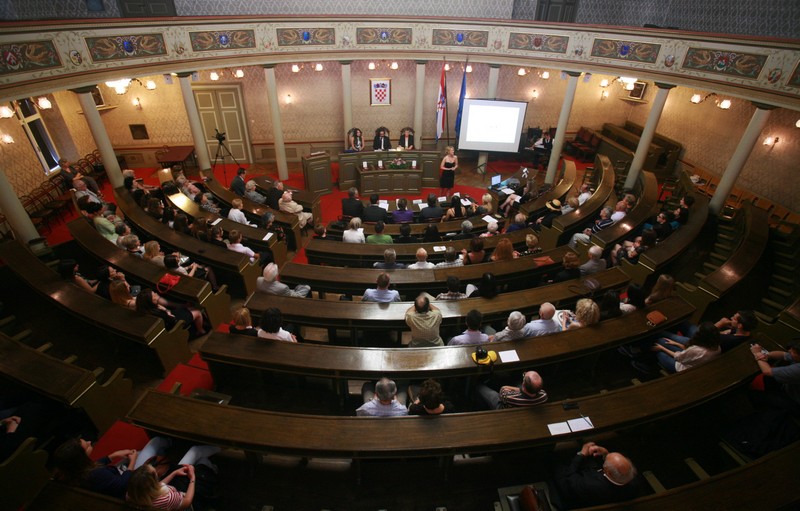
In 1892, Nikola Tesla was hosted in the main hall of the Zagreb City Council.
On the photo, celebration of 130th anniversary of the Croatian Shorthand Society (Hrvatsko stenografsko društvo) in Zagreb, founded in 1882.
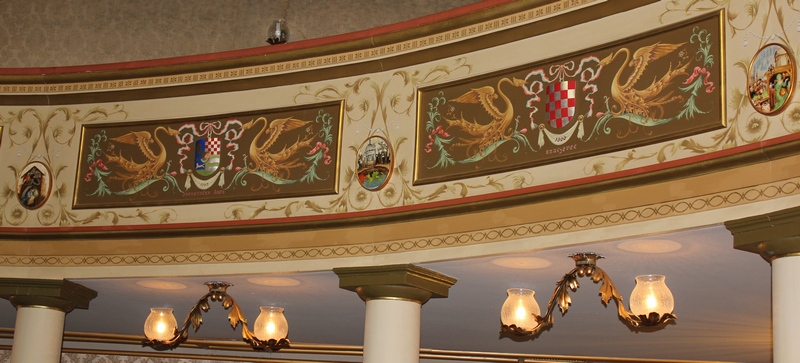
Beautiful Croatian Coats of Arms decorating the main hall of the Zagreb City Council, in which Nikola Tesla was hosted.
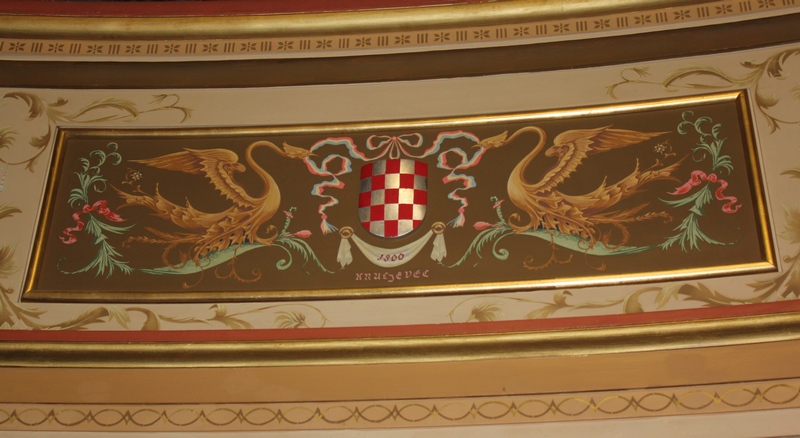
Croatian Coat of Arms is among the most beutiful in the world
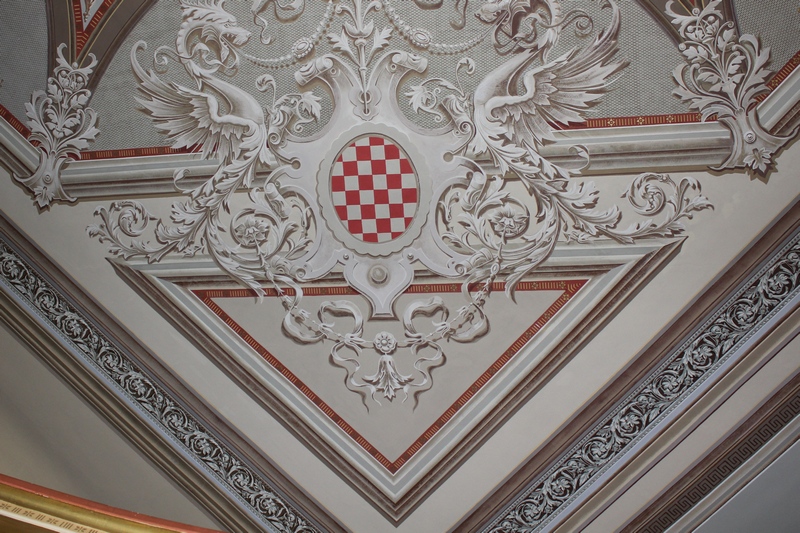
Croatian Coat of Arms on the ceiling of the Zagreb City Council
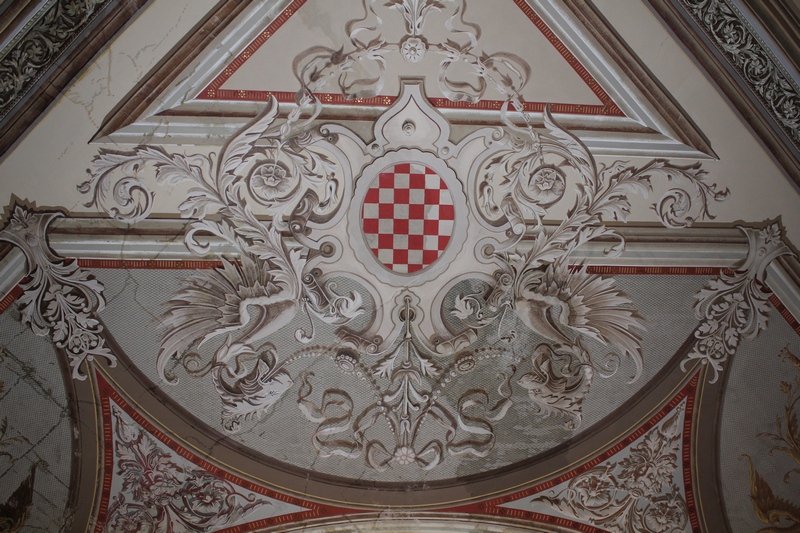
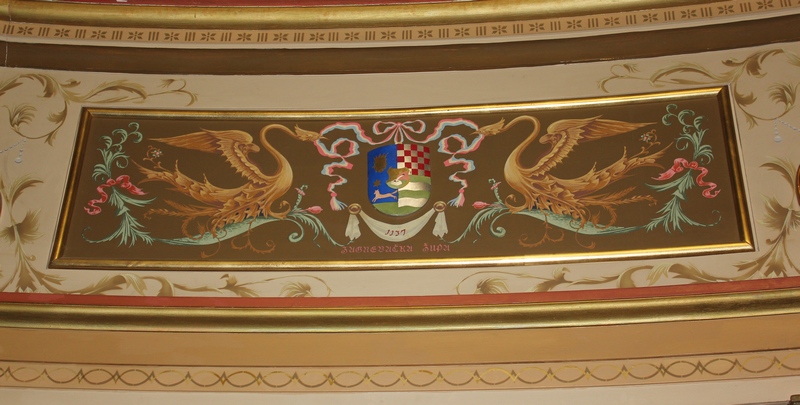
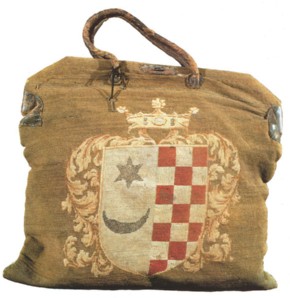
A bag of Ljudevit Gaj (Ludwig von Gay), 19th century
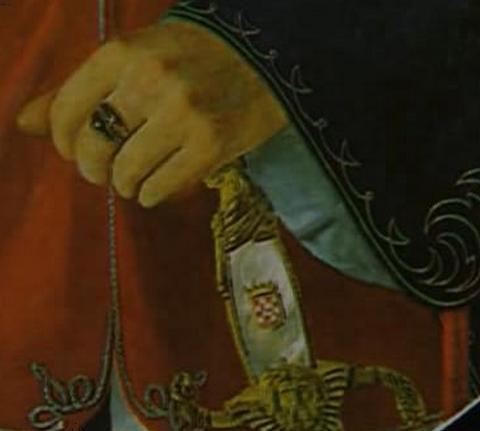
Detail with Croatian coat of arms on a portrait
by distinguished Croatian painter Vjekoslav Karas (1821-1858)
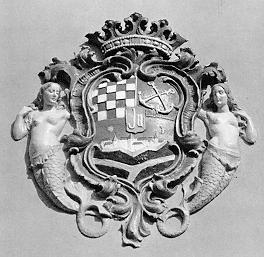
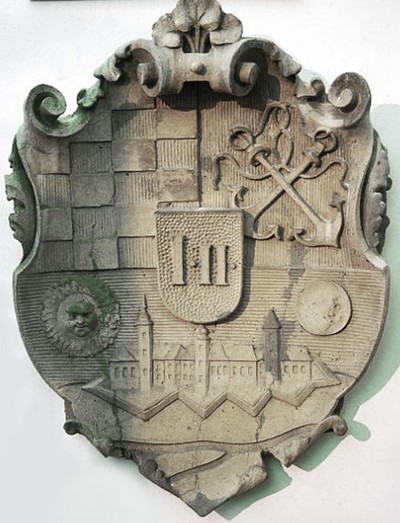
Coats of arms of the town of Karlovac, 19th century
Historical zupanija coats of arms in Croatia containing red and silver squares:
Bjelovar 1872, Krizevci 1759, Rijeka 1864, Severin 1772, Zagreb 1759
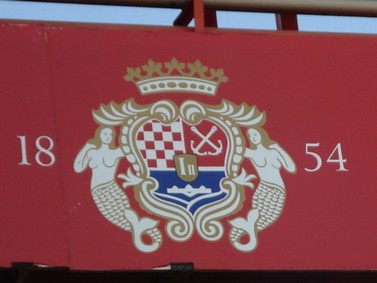
The Karlovac beer, 1854 (Karlovacko pivo)
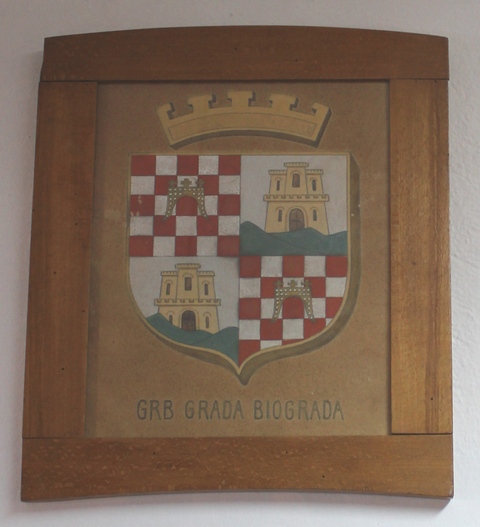
Coat of Arms of the city of Biograd, 19th century, kept in the City Museum of Biograd.
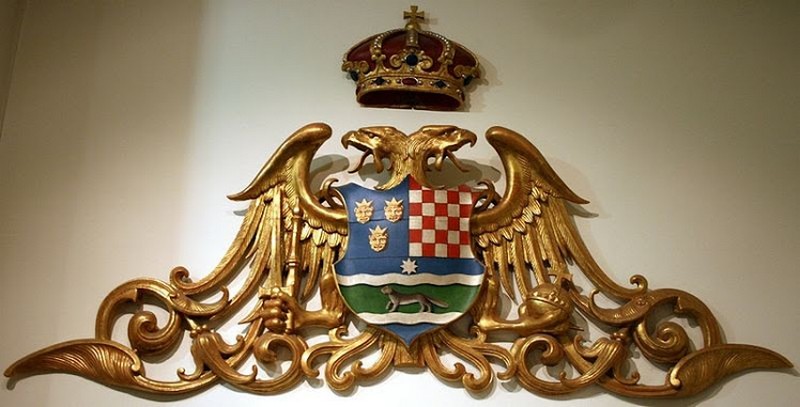
Croatian Coat of Arms from the 19th century, kept in the Museum of the City of Zagreb.
It represents the United Kingdom of Dalmatia, Croatia and Slavonia (Trojedna Kraljevina Dalmacija, Hrvatska i Slavonija):
three leopard heads on the left represent Dalmatia, to its right is the coat of arms of Croatia,
and below is the coat of arms of Slavonia, with kuna (marten) on the green surface.
The KUNA (i.e., HRK = Hrvatska kuna = Croatian Kuna) is the official Croatian currency,
the name of which was inspired by the usage of marten's skin for paying since the 12th century.
The small star, visible in the middle, represents the city of Zagreb.
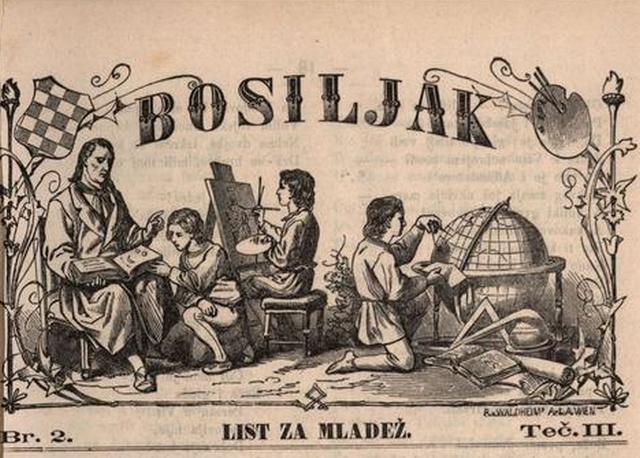
Bosiljak (Basil), journal for youth, the issue from 1866, Zagreb
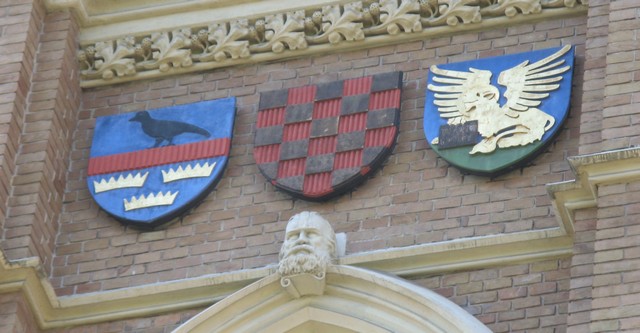
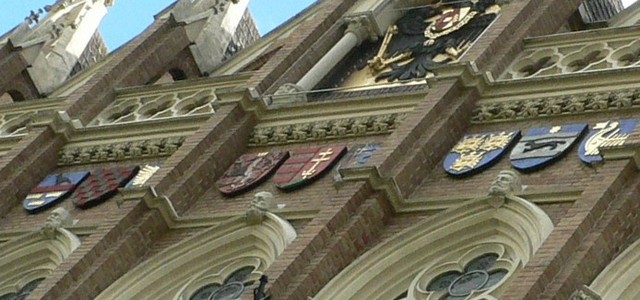
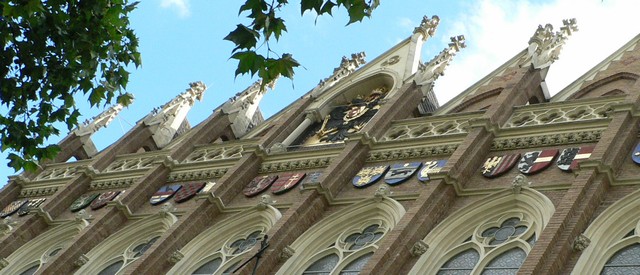
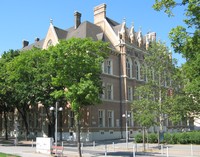
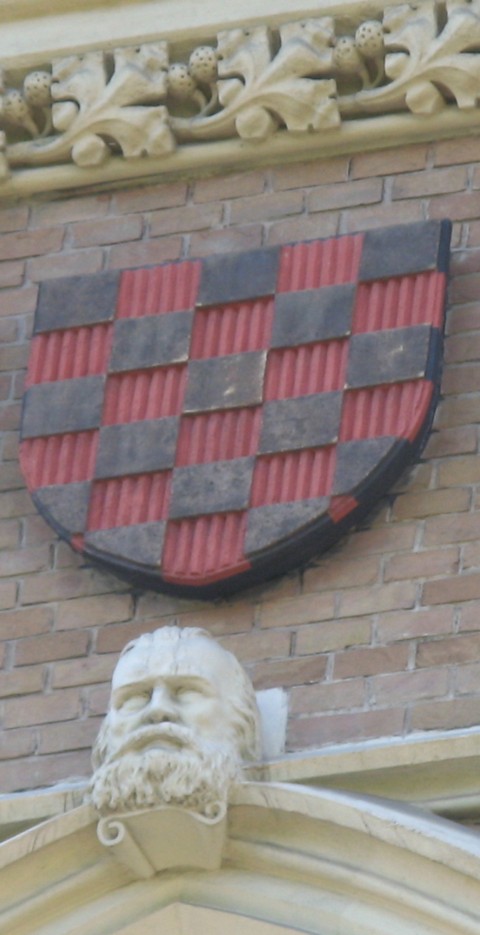
Croatian Coat of Arms in Vienna, captial of Austria, Akademisches Gymnasium (1863-1866),
Beethovenplatz 1. The Gymnasium was founded in 1553, but in 1866 it moved to the new building. The Coats of Arms are from the middle of the 19th century.
The gymnasium was attended by distinguished people, like Erwin ScrhĂśdinger, a famous physicist and Nobel Prizer winner.
Photo by the courtesy of Mr. Kristian Dumancic, Vienna.
Glasses with Croatian Coata of Arms from the mid 19th century, produced in Croatia,
kept in the
Museum of Arts and Crafts, Zagreb.
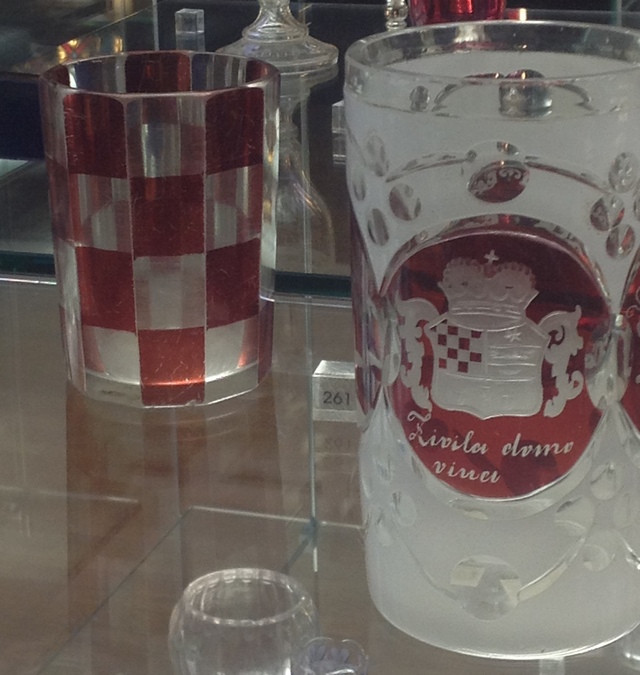
Živila domovina - Long Live Homeland
Two glasses with Croatian Coats of Arms made in Osredek, the left one from 1840-1845, and the right one from the middle of the 19th century,
both kept in the Museum of Arts and Crafts (Muzej za umjetnost i obrt), Zagreb
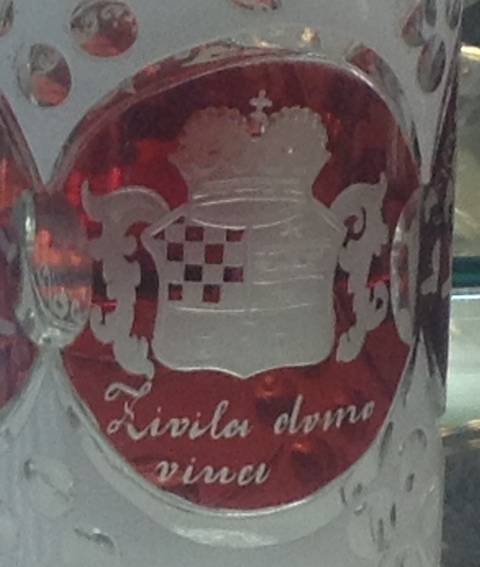
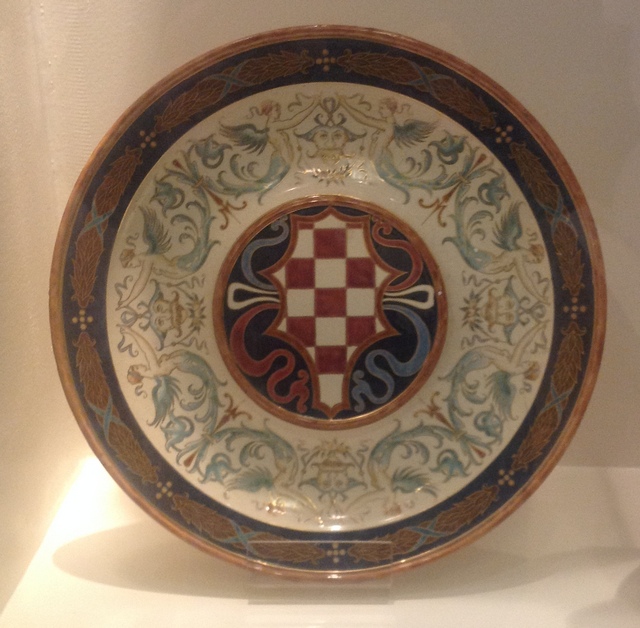
A plate with Croatian Coat of Arms, Obrtnička škola (Crafts School), Zagreb 1887,
kept in the Museum of Arts and Crafts, Zagreb
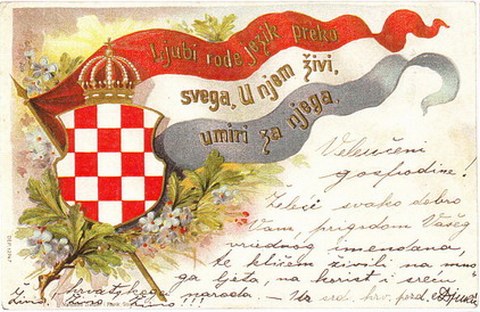
Postcard with Croatian Coat of Arms from the 19th century.
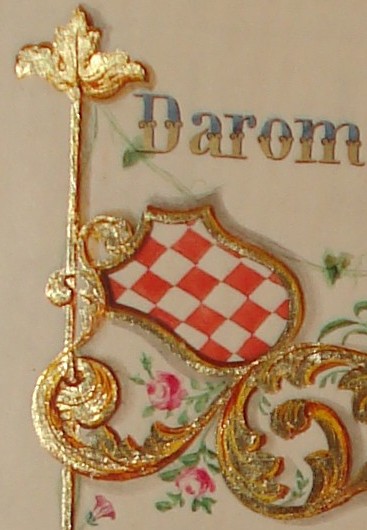
Donors of the Croatian Music Hall (Hrvatski glazbeni zavod, Gunduliceva 6, Zagreb), 1871,
inscribed in the golden book; a part of exhibition at HGZ
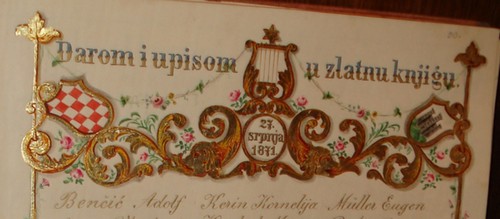
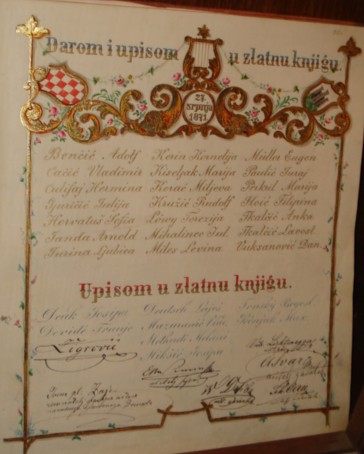
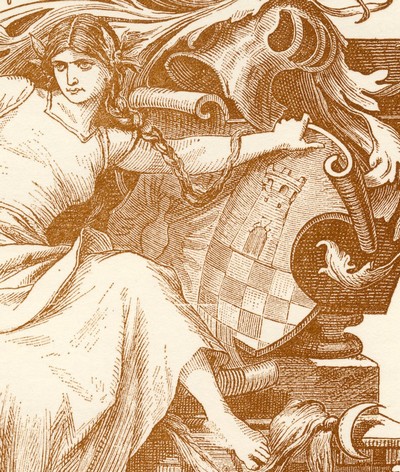
A detail from the announcement of the opera
Nikola Subic Zrinski by Ivan Zajc, 1876.
The most popular air of the opera is
U Boj, known also in Japan since 1919!
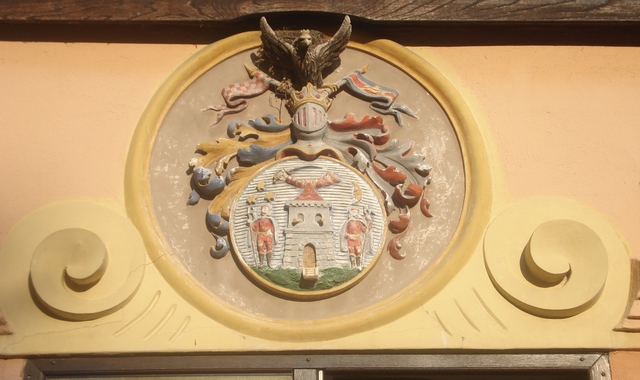
Croatian Coat of Arms above the main entrance of the Turopolje Museum, Velika Gorica, near Zagreb.
This is the coat of arms of
Plemenita turopoljska općina - Noble Turopolje District.

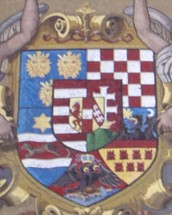
Coat of Arms of Hungary, Dalmatia, Croatia, Slavonia, Transylvania, 1880, Budapest
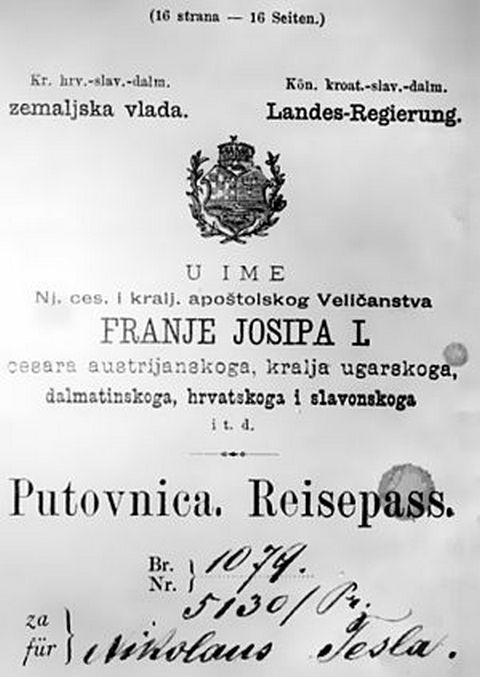
The name of
Tesla is written as Nikolaus.
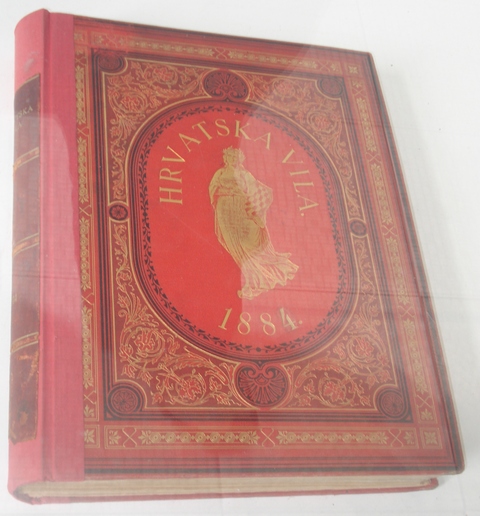
Hrvatska vila - Croatian Fairy 1884
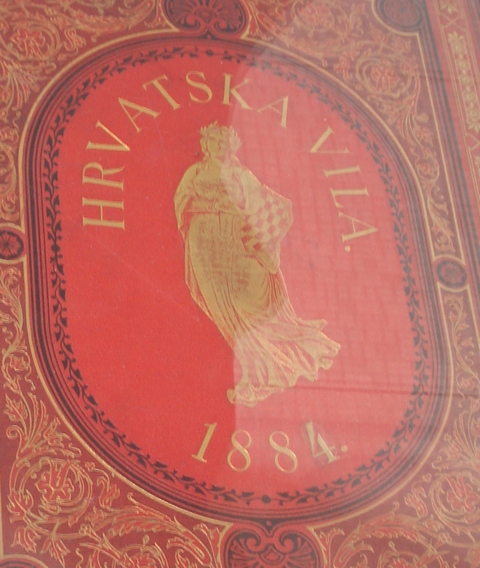
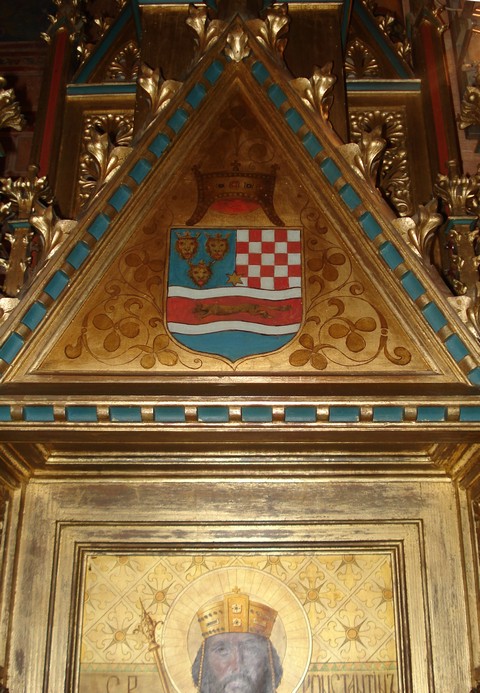
Croatian Coat of Arms from 1890s in Greek Catholich Cathedral of Holy Trinity in Križevci
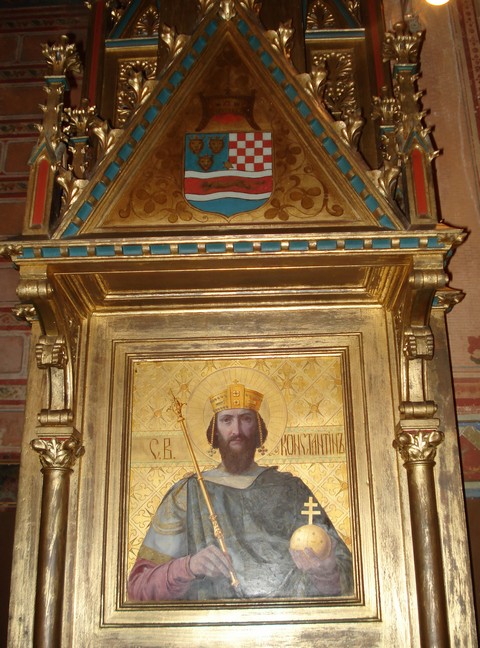
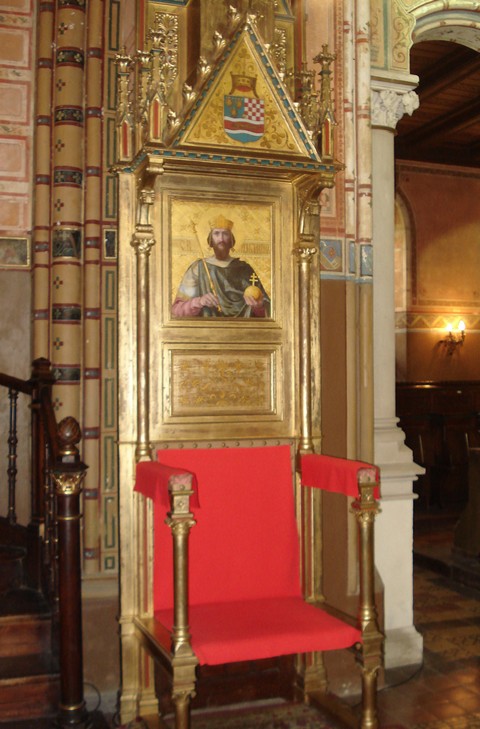
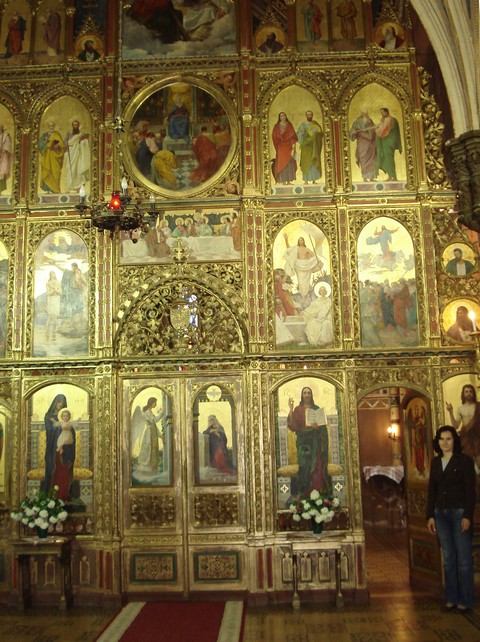
Iconostas in the Greek Catholic Cathedral of Holy Trinity in Križevci, an old Croatian town founded in 12th century, about 100 km from Zagreb. The above Croatian Coat of Arms is placed on the left of iconostas. The iconostasis and the pictures on the walls are works of famous Croatian painters including Ivan Tišov (he also made pictures in the Greek Catholic Church in Zagreb), Celestin Medović and Bela Čikoš-Sesija.

Zvonimir Croatian Illustrated Calendar, 1891,
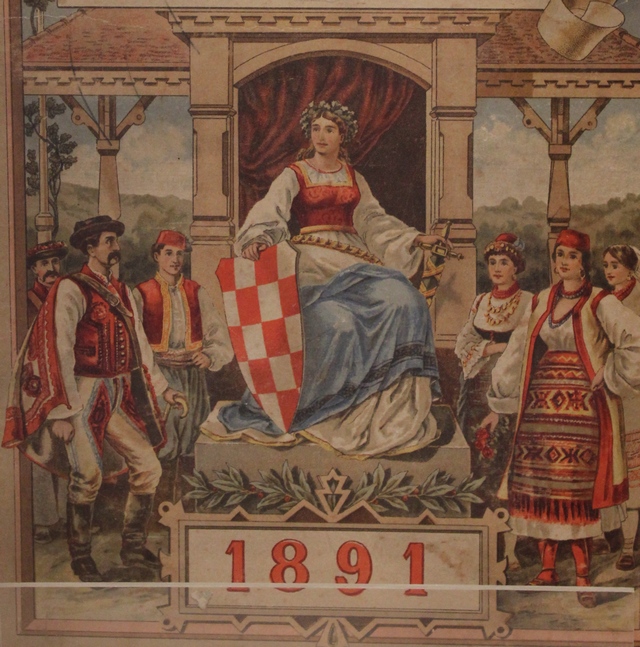
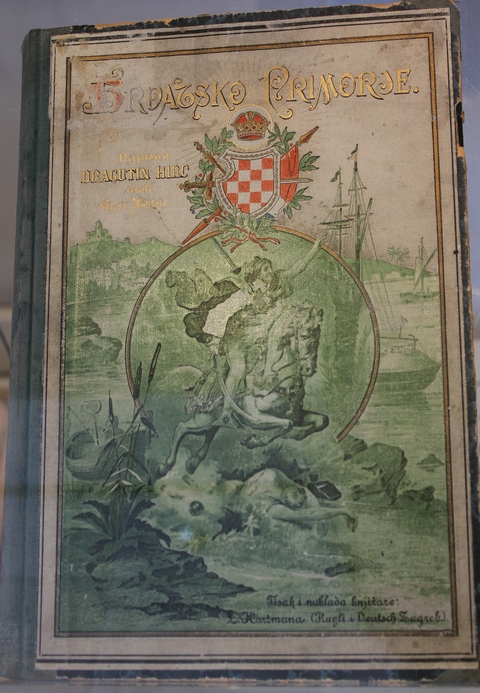
Dragutin Hirc: Hrvatsko Primorje (Croatian Littoral, )Zagreb, 1891.
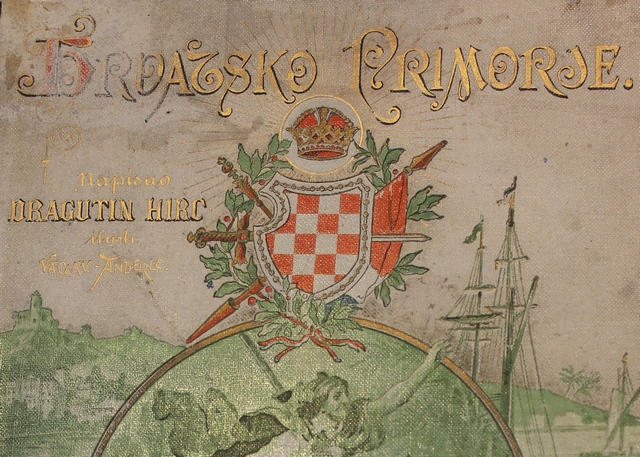

A detail from the ceremonial curtain of the Croatian National Theatre, Zagreb, by Vlaho Bukovac, 1895
Pope Benedict XVI in Croatian National Theatre in Zagreb on 4 June 2011.
Note the Croatian Coat of Arms behind him, on the solemn curtain of the theatre, designed by
Vlaho Bukovac in 1895.
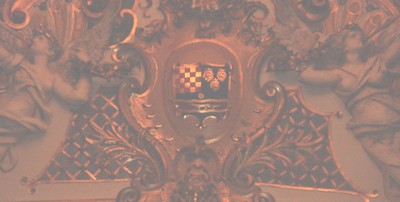
Central part of the ceiling of Croatian National Theatre in Zagreb, 1895
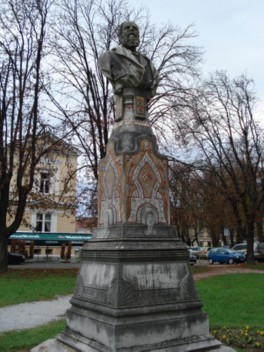
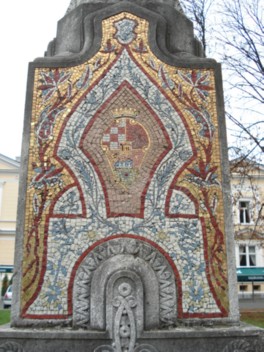
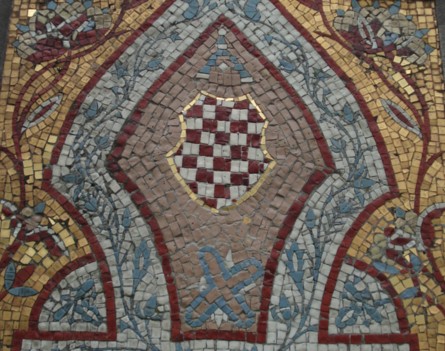
Croatian historian Radoslav Lopasic, city of Karlovac (Zorin dom park), carved by Ivan Rendic, 1896.
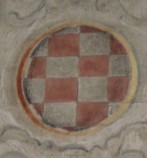

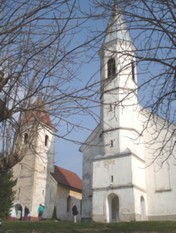
Croatian coats of arms, 19th century, in the Greek Catholic church of St. Peter and Paul in Sosice, Zumberak
(the Roman Catholic church on the left is just by the Greek Catholic church)
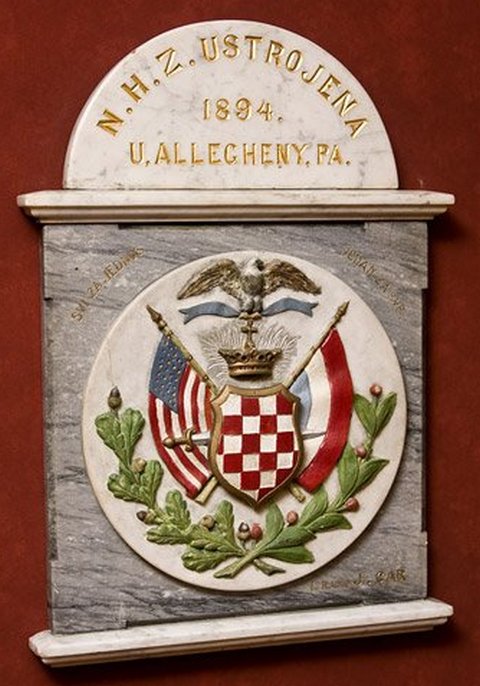
N.H.Z - Nacionalna hrvatska zajednica = Croatian National Community,
founded in 1894 in the USA, a predecessor of the Croatian Fraternal Union CFU.
Source.
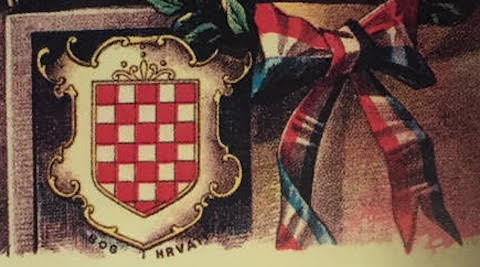
Miho Jerinić: Sladke uzpomene i Božićna jabuka, Beč 1896
(Sweet Remembrences and Christmas Apple, Vienna 1896), a detail
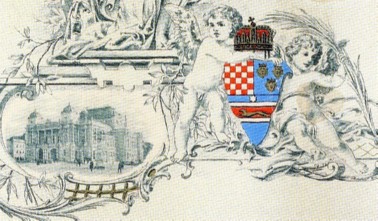
1898 Charter from the Croatian National Theatre in Zagreb conferring honorary membership to Milka Trnina,
a famous Croatian opera singer (source [Premerl, p 86]),
with the Coat of Arms of the United Kingdom of Croatia, Dalmatia and Slavonia
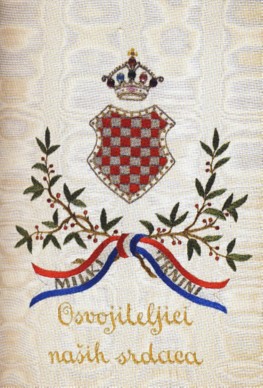
Folder containing poems dedicated to Milka Trnina, Zagreb, 1898 (source [Premerl, p 87])
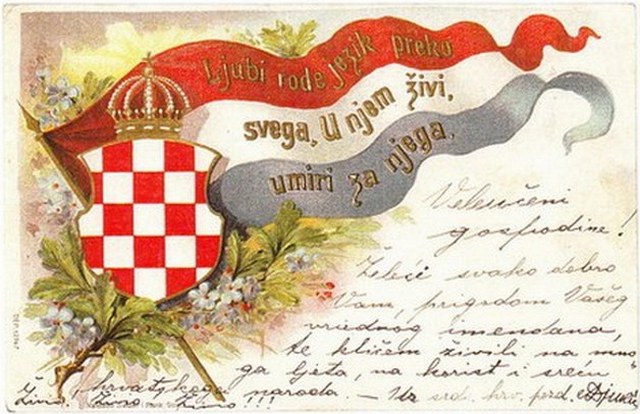
Petar Preradović (1818--1872.): Ljubi rode jezik preko svega. U njem živi, umiri za njega.
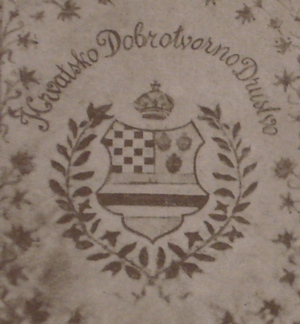
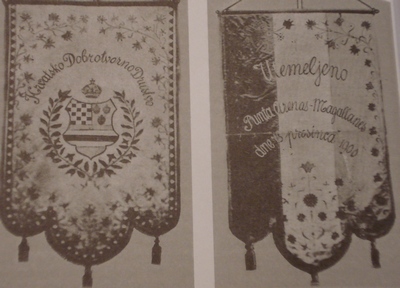
Croatian Benefactor's Society, Punta Arenas - Magellanes, Chile, 1900
Hrvatsko Dobrotvorno Društvo, Utemeljno dne 13 prosinca 1900
photo from [Glasinovic, p 70]
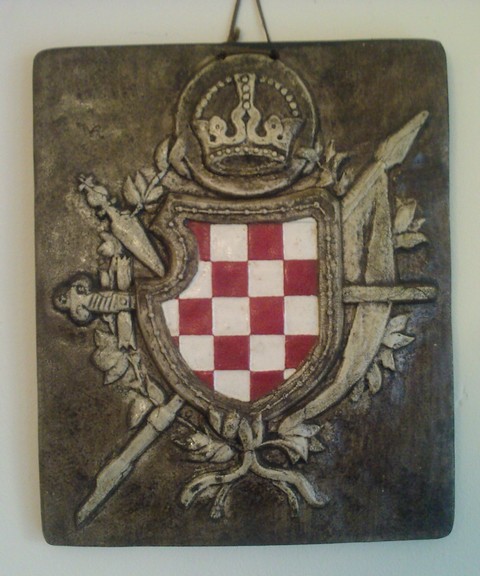
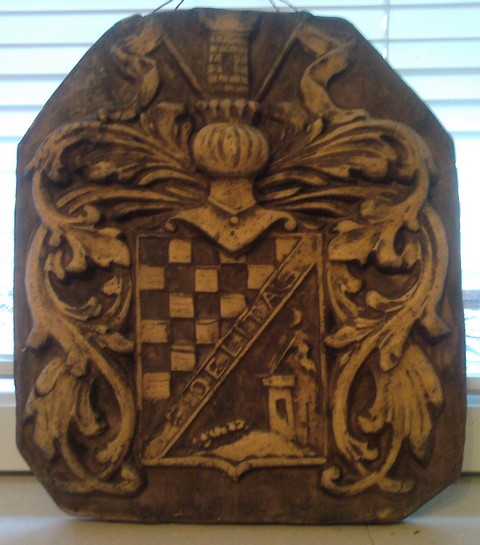
Two Croatian Coats of Arms (the second one with inscription FIDELITAS along the diagonal), probably from
the end of 19th or beginning of 20th centuriey. Many thanks to Mr Ivan Filipčić, Zagreb, for the photos.
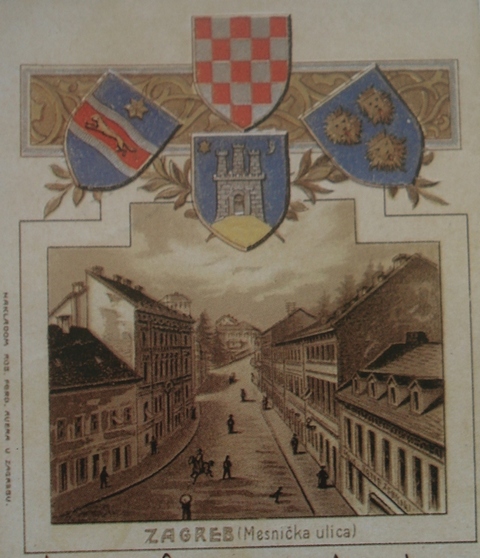
Zagreb, Coat of Arms of Croatia, Slavonia and Dalmatia;
below them the Coat of Arms of the City of Zagreb;
Mesnička street in Zagreb
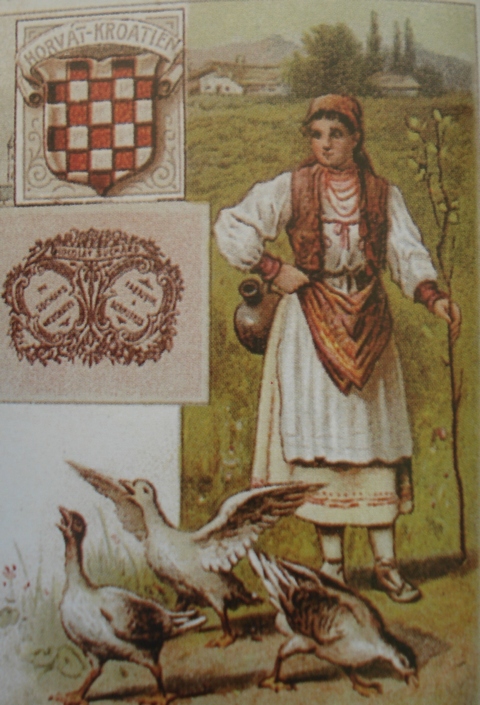
A detail of a postcard containing Croatian Coat of Arms

Croatian Coat of Arms from 1890 in Nazorova street 51 in Zagreb:
Public Orphanage of Eduard Baron Jellachich Bužimski
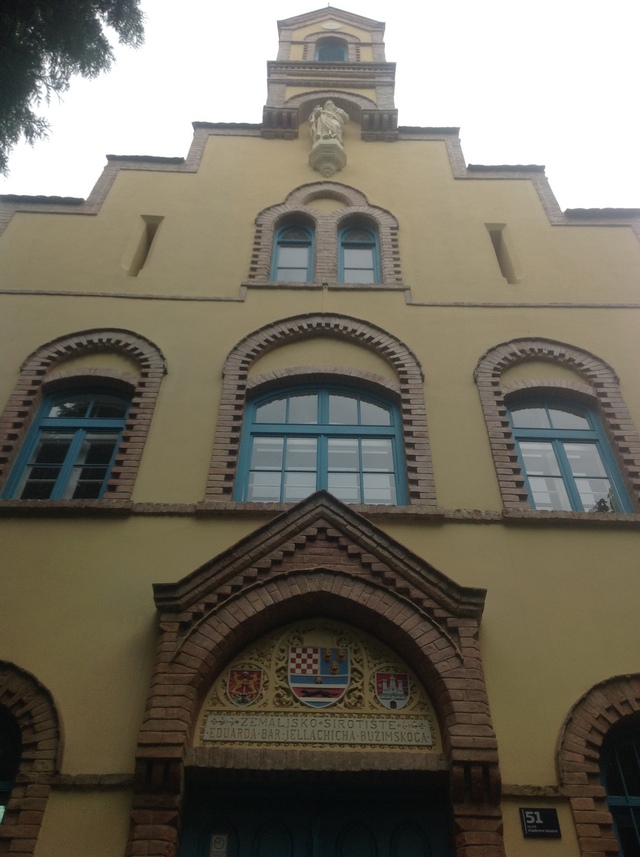 Built in 1879
Built in 1879 as convent with the chapel for sisters of St. Magdalena,
in 1886 it was bought by Croatian government and rebuilt as an orphanage.
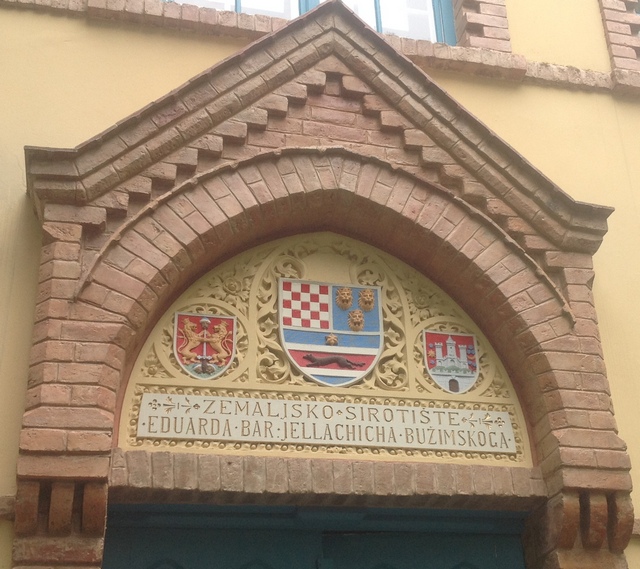
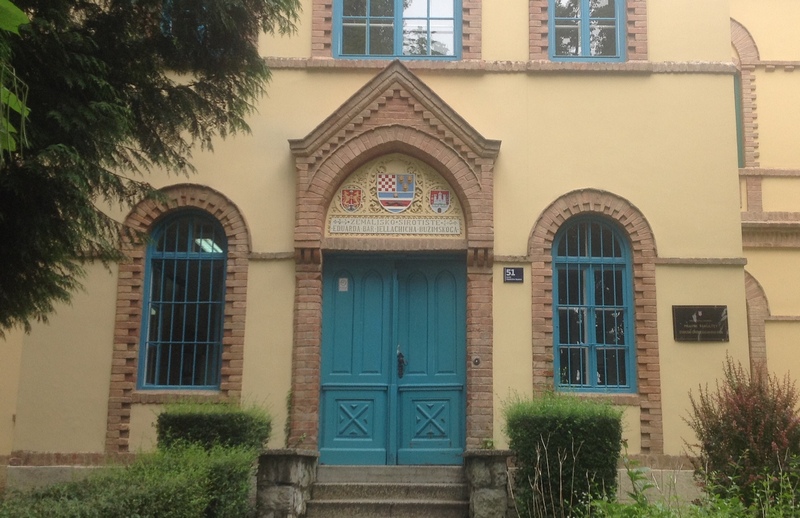
Now a part of the Faculty of Law of the University of Zagreb
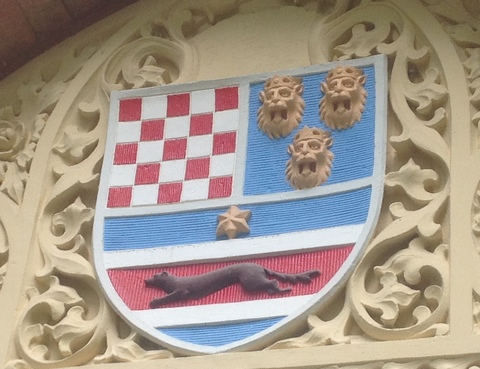
Coat of Arms of the United Kingdom (Trojedna Kraljevina) of Croatia, Dalmatia and Slavonia
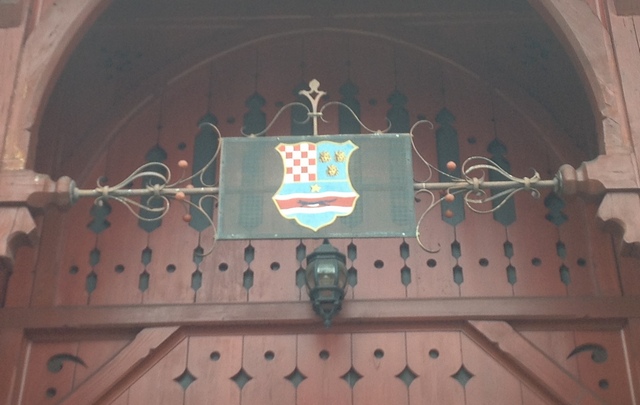
Croatian Coat of Arms from 1892 in the
Botanical Garden, Zagreb
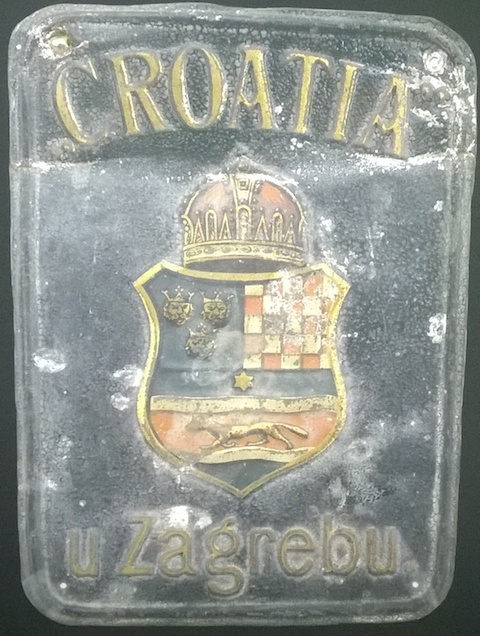
Croatia osiguranje (Croatia Insurance), 19-20th century
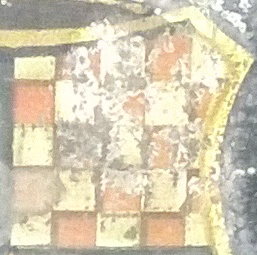
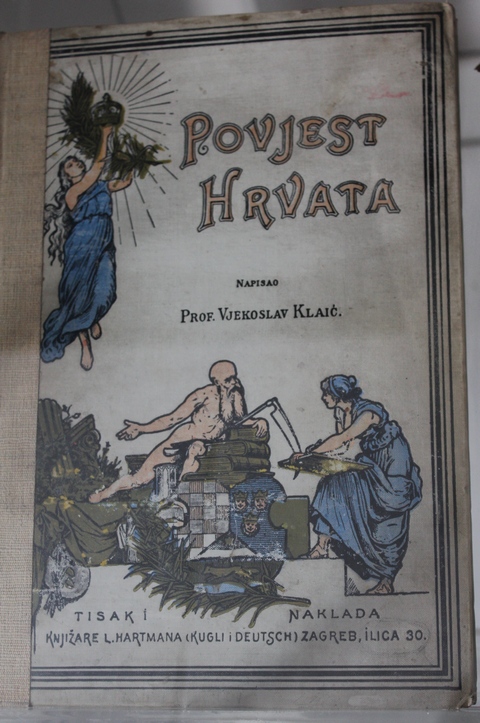
Vjekoslav Klaić:
History of the Croats, Zagreb, 1899.
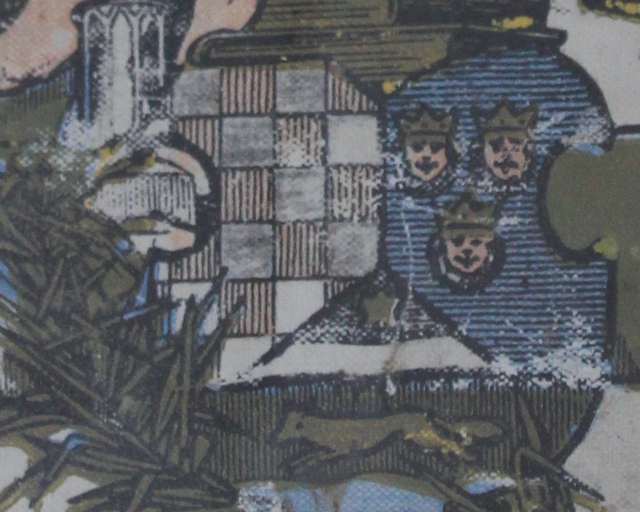
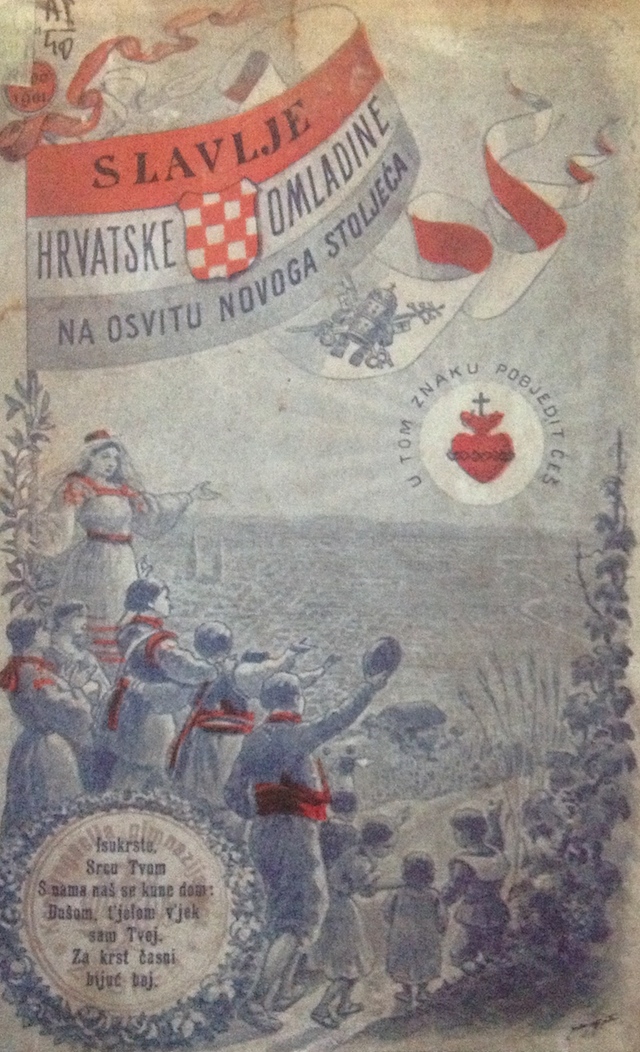
Celebration of Croatian Youth on the occasion of the entrance to the 20th century, 1900-1901
(the title page of the brochure).
Formated for CROWN by Darko Žubrinić
Distributed by www.Croatia.org . This message is intended for Croatian Associations/Institutions and their Friends in Croatia and in the World. The opinions/articles expressed on this list do not reflect personal opinions of the moderator. If the reader of this message is not the intended recipient, please delete or destroy all copies of this communication and please, let us know!